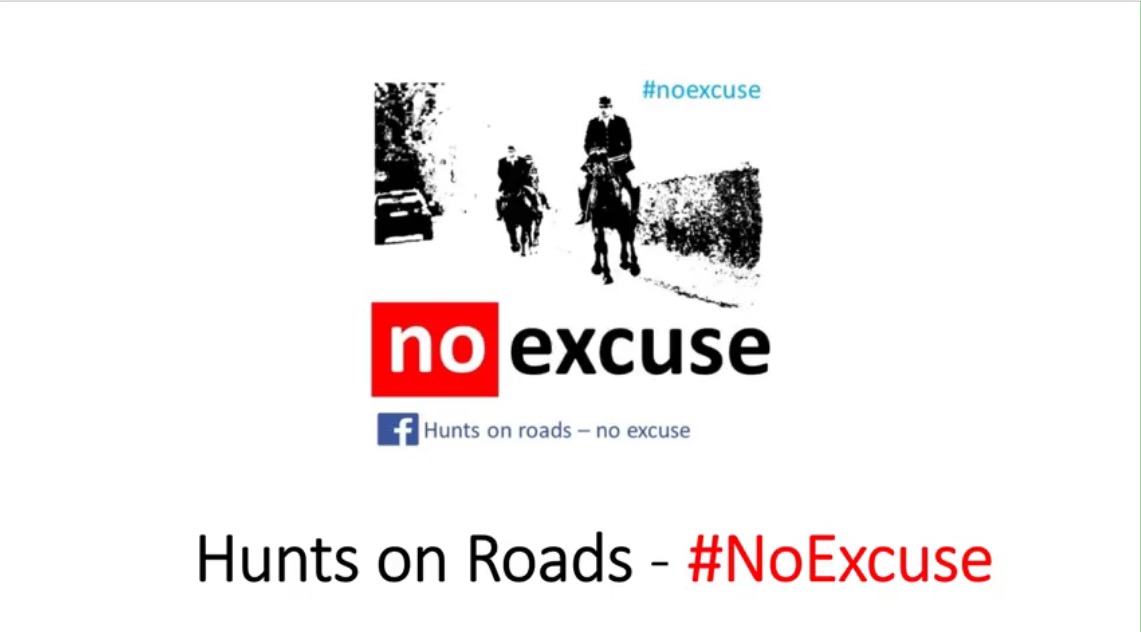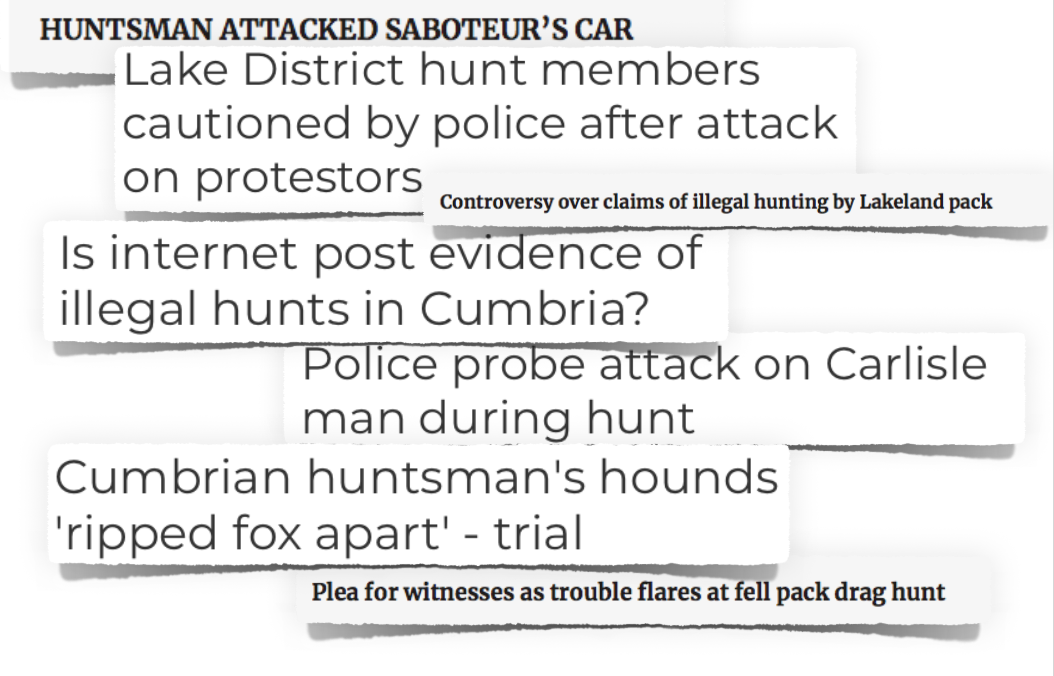3rd March 2019
Staghunting: And So It Continues…..
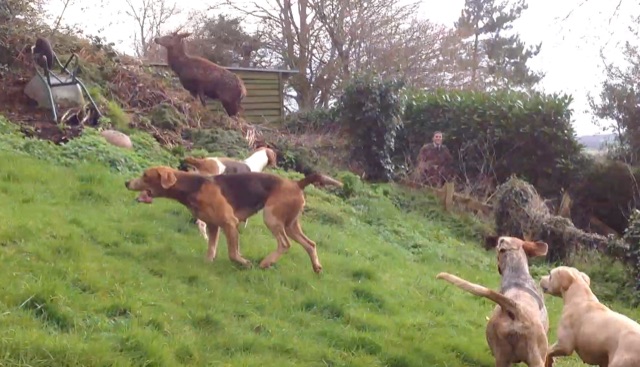 Stag at bay on a compost heap in a private garden adjacent to National Trust property on the Quantock Hills, March 2017. Photo © Hounds Off, with permission only
Stag at bay on a compost heap in a private garden adjacent to National Trust property on the Quantock Hills, March 2017. Photo © Hounds Off, with permission only
March 1st is when Spring Staghunting starts on the Quantock Hills and Exmoor. ‘Spring’ stags are the young adults, the stags with most energy and va-va-voom. These are a staghunters favourite quarry because they run hard, fast and long. For those who delight in chasing then killing fit and healthy Red deer then March and April are the most exciting months of the year.
Two years ago Teresa, a Quantock Hills resident, contacted Hounds Off and told us her story.
Teresa was in her kitchen. It was just after lunchtime. She could hear the Quantock Stag Hounds hunting really close and then saw out the window a hound by her garden pond. She grabbed her iPad to and went outside to take some film. The noise was suddenly deafening. There was a stag in her garden, up by the summerhouse. Other hounds were in the garden too and the stag moved towards the compost heap.
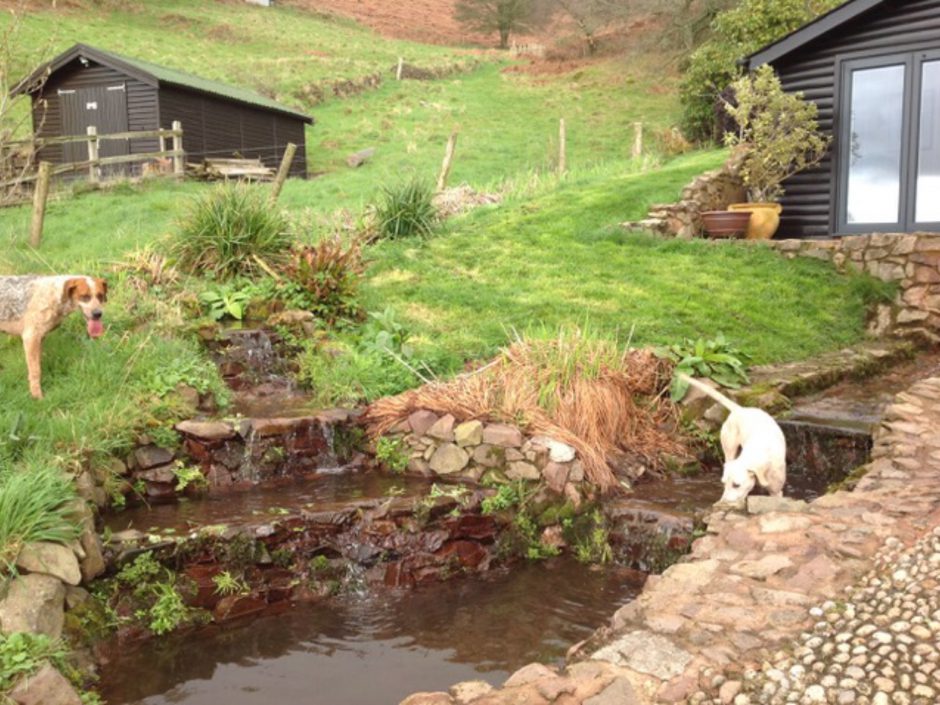
Hunting dogs from the Quantock Stag Hounds by Teresa’s garden pond. © Hounds Off, with permission
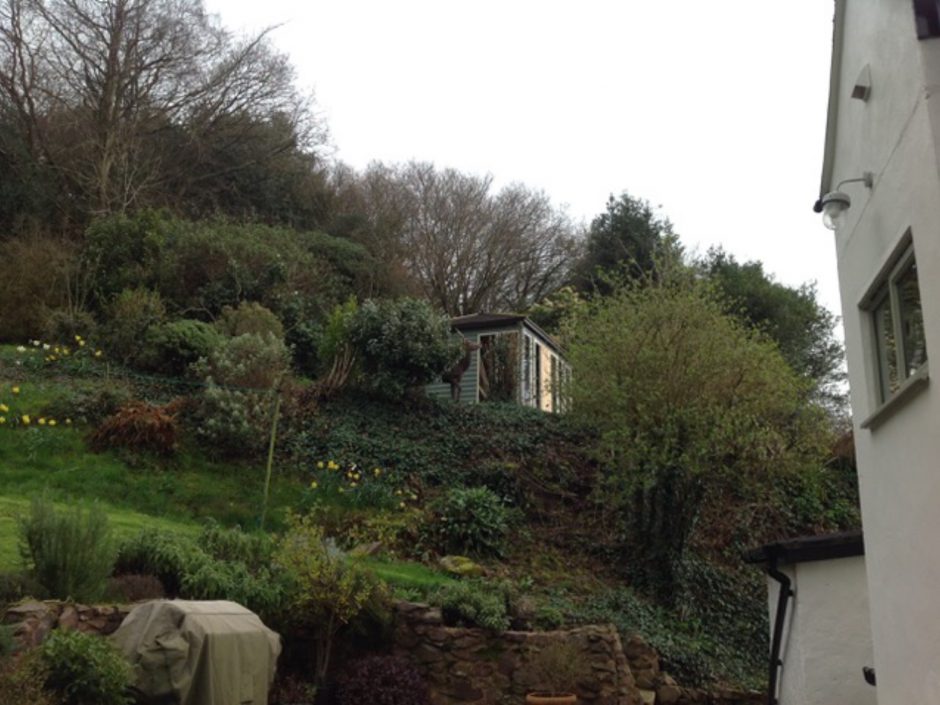
The hunted stag by the summerhouse © Hounds Off, with permission
A huntsman was just beyond the garden fence. He asked Teresa for permission to shoot the stag and she said, “No”. She asked the man his name and what he was doing. He said that she didn’t need to know. More hounds came in to the garden. Teresa reckoned there were about seven but they were hard to count because of so much movement.
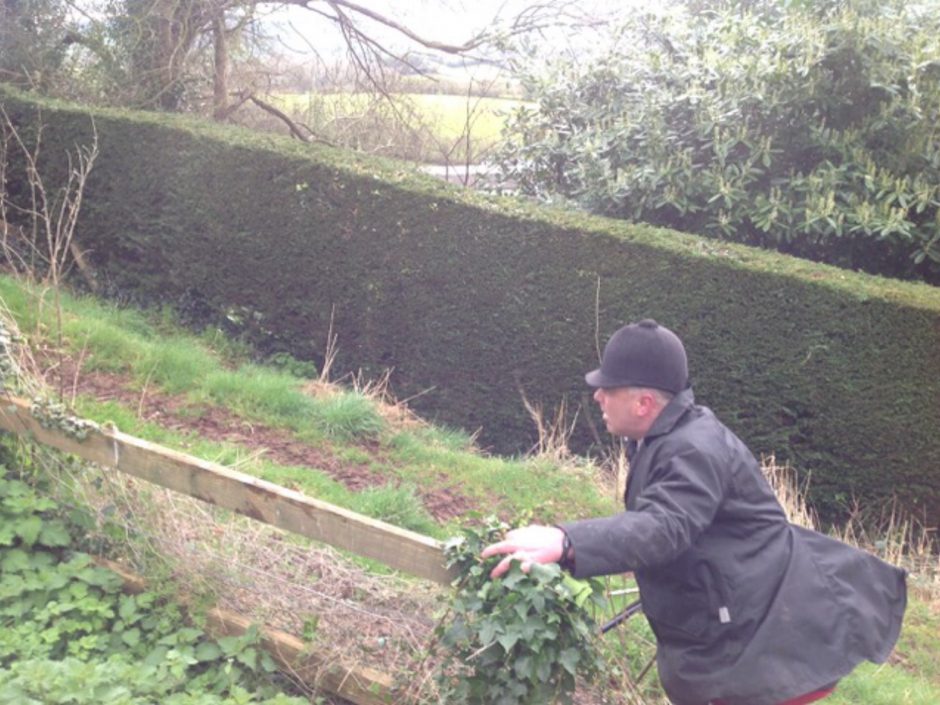
Teresa refused to let the Quantock Stag Hounds Huntsman shoot the stag in her garden. © Hounds Off, with permission
By now the stag had climbed on top of the compost heap. There were riders looking down from the hill up above and conversations could be heard between unseen hunters on walkie-talkies. Numerous vehicles were parked on her private entrance drive with people standing and watching.
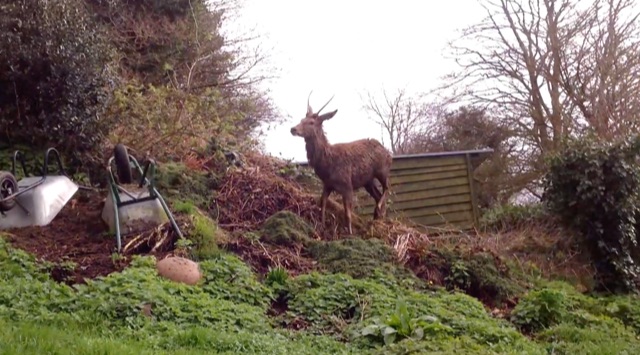
The hunted stag on the compost heap, using the height for protection. © Hounds Off, with permission
Suddenly there were four burly men at close quarters. The man who wanted to shoot the stag warned Teresa not to interfere in case the dogs attacked her. She was frightened because, as she told us afterwards, “I was outnumbered and could see that their blood was up.”
The dogs had chased the stag off the compost heap but he returned and was again at bay.

Stag at bay on a compost heap in a private garden adjacent to National Trust property on the Quantock Hills, March 2017. Photo © Hounds Off, with permission only
Teresa said, “The stag was surrounded by hounds and huntsmen and was clearly exhausted and petrified. I felt I needed to protect it. I felt strongly that it was not just right that I protect it, but it was my right to protect it. Not just because I don’t agree with hunting with dogs, but because it was in my garden and I should have been able to save it. My garden was its sanctuary.”
Again, she told the hunters to call their hounds off. One young, thick-set individual threatened to call the police because he said she was “harbouring a deer.” He also threatened to call the RSPCA, shouting that the stag was injured and had to be killed. But they did manhandle their dogs over the fence and remove themselves as well.
Another man who Teresa didn’t know or recognise appeared. He also refused to identify himself and joined the other hunters. They huddled together and then, right in front of Teresa, stormed into her garden, ran towards the stag and physically pushed it off the compost heap, over the fence and away towards private farmland. The men and their dogs, the riders and the people in cars all followed in different directions as fast as they could.
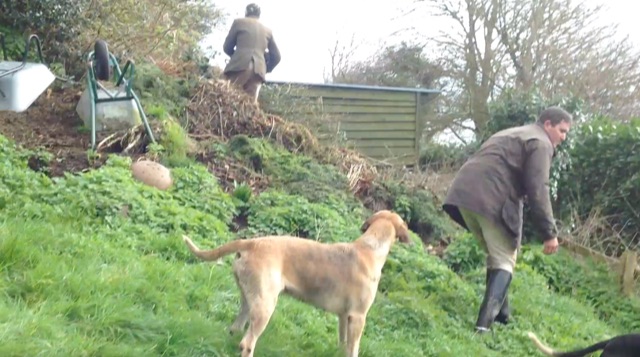
Quantock Stag Hounds men and dogs trespassed with menace to get the hunted stag running again. © Hounds Off, with permission
Teresa was totally shocked and shaken. She immediately called the police to report the incident.
A couple of hours later two huntspeople called at the house. Only one of them would give his name. He said that they were “trailhunting” with eleven hounds when unfortunately this young, injured stag jumped up in front and caused a distraction. They decided to kill it because, apparently, it was injured. Their excuses were not believed and apologies not accepted.
“A day later the Huntsman left a message to tell me the stag had been previously shot by a .22 rifle. I learnt later from the police it was in the chest,” Teresa recalled, “But this exposed them as liars. I was stood ten feet away from the stag for some time. There was no injury to the chest, old or new, but it was exhausted. I didn’t realize it then, but subsequently I found out that they have used this excuse before to exploit a loophole in the Hunting Act. I thought at the time that it was a really odd thing to say that they would call the police because ‘I was harbouring a sick deer’, but I later realized that they worked out which angle they were going to use to get out of this, hence why they didn’t care about me filming.”
Avon & Somerset Constabulary completely failed to take Teresa’s allegation of illegal hunting seriously and it appears that there was a deliberate block put on conducting even a cursory investigation. The Quantock Stag Hounds got away with it. But we helped call the police failures to account. Crucially, over a year later their own Professional Standards Department upheld six out of nine points of complaint.
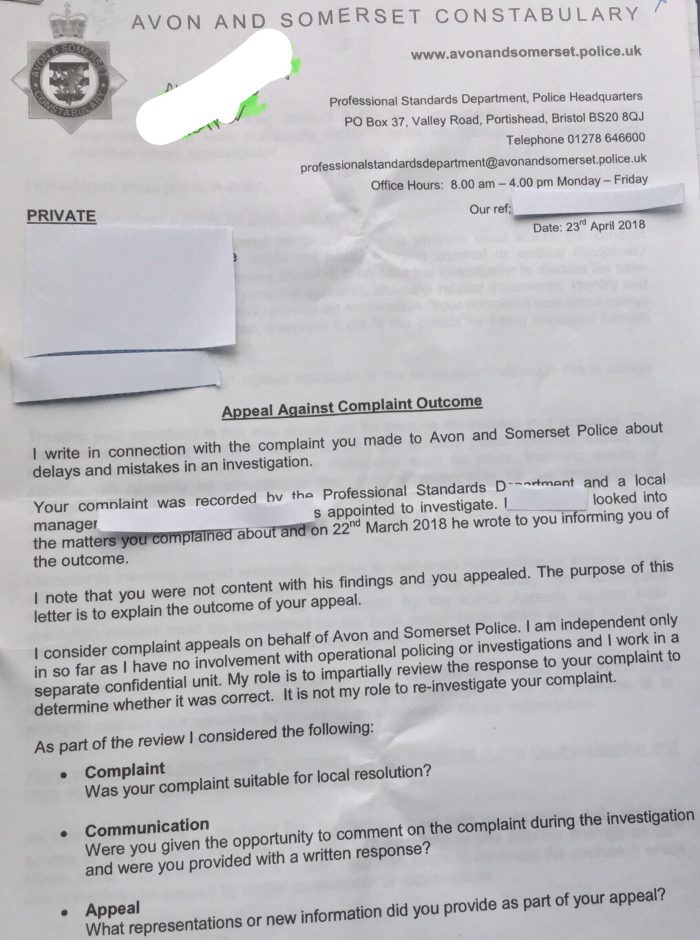
First of a seven page letter upholding six out of nine points of complaint made by Teresa. © Hounds Off
Teresa said, “When I reflect back with the knowledge I have gained over the last two years, I know that the Hunting Act has to change. Any reasonable person looking at the facts knows exactly what these hunts are up to. But the legal system is choosing to ignore the test of the reasonable person. As it stands today it is almost impossible to prove illegal hunting and get a conviction.”
Her immediate neighbours are the National Trust and she feels let down by them, too. Despite receiving all the evidence and her witness statement, and despite the fact that they themselves banned deer hunting with dogs on their land in 1997, the Quantock Stag Hounds frequently hunt across forbidden land. As recently as January 28th this year they held a fundraising meet and then hunted on National Trust land. Clearly this is unacceptable and we are in dialogue with the Trust to work out how to prevent future arrogant flouting.
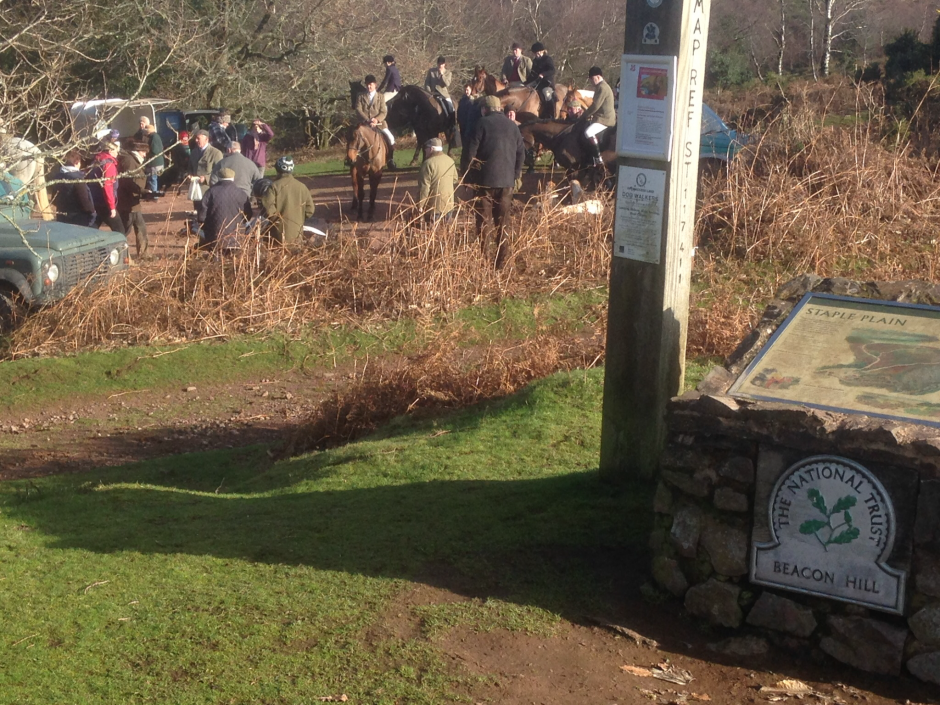
Members of the Quantock Stag Hounds meet on National Trust land at Beacon Hill Car Park, Staple Plain, West Quantoxhead, Somerset on Monday 28 January 2019. The National Trust banned all deer hunting with dogs from their properties in 1997. Photo © Hounds Off
Rural residents have turned to us in desperation and we answered their call. Our tactics are simple; in partnership with Somerset Wildlife Crime and individuals, groups and organisations who want to work with us, we’re shining a light on modern day staghunting. Please see the following links for more details:
- Your Membership (of the National Trust) And Voice Matters
- Staghunting On The Quantock Hills 08.10.18
- Press Release: Staghunting In Somerset, October 2018
- Nowhere To Hide
- Another Wretched day With The Quantock Stag Hounds
- Quantock Stag Hounds Meet Fundraise Hunt On National Trust Land 28.01.09
- How To Report Hunt Incidents To The National Trust
- Stag Hunters Break Convention To Ensure Valentines Day Sport
- Quantock Stag Hounds After Another One
Please consider . We couldn’t do what we do without you.
© Joe Hashman. Founder; Hounds Off
9th October 2018
Staghunting On The Quantock Hills 08.10.18
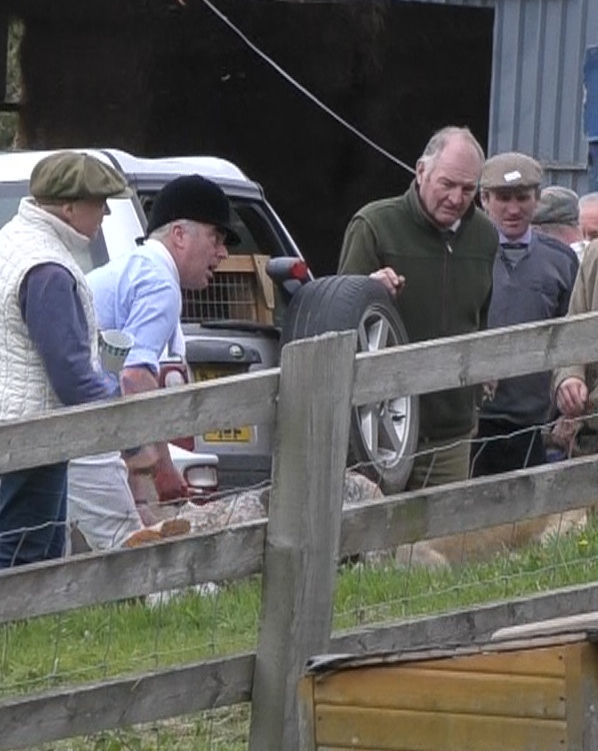 Scene from Quantock Stag Hounds carve up at Staple Farm, West Quantoxhead, Somerset, 8 October 2018.
Scene from Quantock Stag Hounds carve up at Staple Farm, West Quantoxhead, Somerset, 8 October 2018.
There was a moment yesterday when I thought that the Quantock Stag Hounds had decided not to go hunting but alas it wasn’t so. In the end they killed a stag and took the body to a farm to carve it up. Men and women supped cans of drink and watched in gory fascination as the Huntsman, elbow deep in warm blood, dished out bits of inneds and butchered the animal at their feet, in front of their eyes.
They started not far from Bishops Lydiard which itself is a stones throw from Taunton. I was part of a team of Hunt Monitors. We were parked near the beauty spot of Lydiard Hill, by some horseboxes. We anticipated that the Hunt would come in this direction.
Shortly after 11am my radio crackled and the message came through that there was movement our way. Then a gaggle of hunt riders came along the lane, gave us a bit of verbal, loaded their horses into the boxes, and drove off. That was when, fleetingly, I vain hoped they were going to leave stags on the Quantock Hills in peace.
Instead, the Hunt relocated. We got a message that they were up Crowcombe and sure enough that’s where they were hunting.
Staghunting on the Quantocks is not what it was. Prosecutions, campaigning pressure and changing attitudes from the police have forced them to stop using a pack of a dozen or more hounds to chase stags to exhaustion. This season, which started at the end of August, they’ve been using two hounds and an army of riders and vehicle followers to chase and chaperone their quarry. It’s a tactic which staghunters on Exmoor have employed for years now and I think they believe it exempts them from prosecution under the Hunting Act.
There were a couple of huntable stags in Crowcombe Park but an especially big fellow was the target. It took a while for the Hunt to flush him up onto the hills but eventually their pressure forced him out.
I was tracking the Quantock Stag Hounds (QSH) in a vehicle, in communication with others who were both mobile and on foot. From hilltops you get some fantastic views but the Quantock Hills are characterised by large blocks of woodland and numerous steep, deep valleys known as ‘combes’. The staghunters know this landscape intimately and are skilled at operating simultaneously in the open yet out of sight, if that makes sense.
The stag was somewhere below a high spot called Bicknoller Post. Horsemen and women lined the tracks and combe sides. The stag didn’t appear keen to run. It’s mating season for Red deer in Devon and Somerset (the ‘rut’) so likely he was pretty tired from all that. I thought they were going to shoot him there and then but no, they wanted some sport.
What followed was not a high speed, high adrenalin gallop and chase over the countryside. It was more akin to a slow walk. The stag kept low among whatever cover he could find to hide in and the hunters, co-ordinated by radios and aided by their two dogs, pushed the deer along and steered him away from our eyes and camera lenses.
We drove into the picturesque village of Holford. By now we had a hunt supporter tailing us. We waited to let a party of schoolchildren pass. I hoped they saw the anti hunting stickers in the car window and that’s why they smiled and waved and shouted hello as adults in yellow tabbards shepherded them safely to the side. Or, more likely, they were just naturally excited to be exploring such a beautiful place.
A sharp right and left and we were in the car park with dog walkers and tourists. Our hunt tail parked up herself and ran to keep tabs on the foot team we deployed. I drove up a remote, single track lane and at the end was a gathering of elderly hunt supporters in cars.
A number of wooded combes with streams converge at Holford and in the recent past it was a favourite killing place for the QSH. But these days they are no longer Kings of the Hills. They skulk more. Red coats have been swapped for fawny brown. They’re quieter. They still take up a lot of space but they try to avoid clogging villages with four-wheel drives and quad bikes. They are adept at chaperoning their stag quite discreetly away from public gaze.
There were moments while we were in Holford. We heard the hunting horn and urgent, loud shouting. Vehicles travelled at dangerous pace on bumpy lanes back and forth. But nothing more than that came our way.
Our teams of Hunt Monitors communicate by walkie-talkie and telephone, neither of which work well in this area of Somerset. It’s hard to be in the right place at the right time anyway but when communications are poor because the signal isn’t great it’s even harder. We believed that the hunted stag had left the Hills for farmland near Kilve but weren’t sure.
The stag was killed south of the A39 near Kilve late in the afternoon, in the depths of private property, and taken to a nearby farmyard for the post-orgasmic ‘carve up’. They were not happy about us trying to take some pictures and it was difficult anyway as they’d hidden themselves behind buildings. Out of sight but not out of our minds.
That was the bloody reality of staghunting on the Quantock Hills this day, 8th October 2018.
Volunteers from Hounds Off and Somerset Wildlife Crime continue to monitor staghunting on the Quantocks, bear witness and gather evidence to show how hunts are operating. You can . Mark your donation ‘QSH’ and we will dedicate it to this specific fund.
© Joe Hashman
2nd September 2018
Hunts On Roads - #NoExcuse
One of the most extraordinary photos Surrey Hunt Monitors has taken is of Morestead Road, near Winchester. It’s an unremarkable road, but at about 2.15pm on Saturday 27 January 2018 it looked like a canine racetrack.
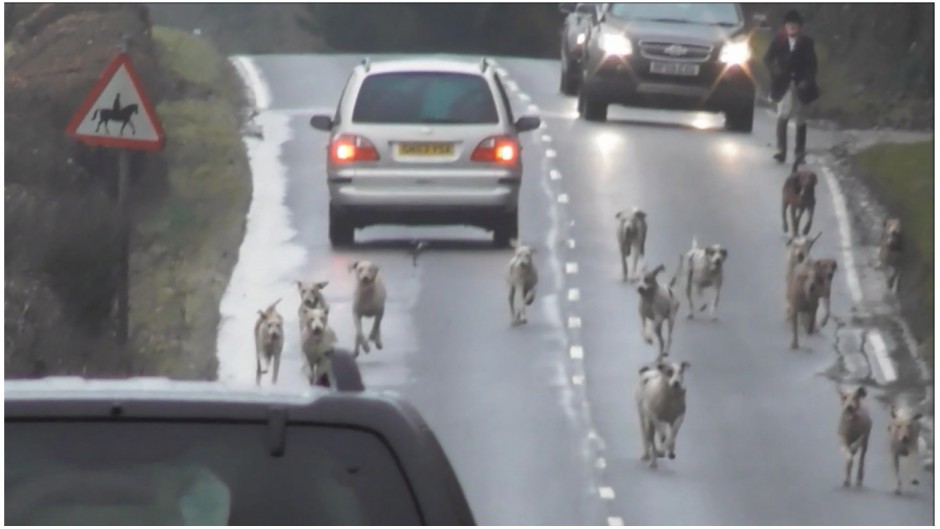
Funny old place to lay a trail. It would be almost as stupid as on the A1(M) motorway in North Yorkshire (28 January 2017), or through a cat sanctuary in Kent (9 January 2018).
Of course it wasn’t actually the case that a trail was laid in any of these places. In each case the hounds had been following animal scents. In the Morestead Road case, the scent was of two deer which had been chased by the hounds and had crossed the road a short while before.
What happened next was referred to on Twitter as #HuntHavoc. It’s a very appropriate term. It risks lives, not just of the animals being chased and the hounds doing the chasing, but also the people driving on the roads who, at any moment can find themselves in the wrong place at the wrong time, like the driver of this car who had to make an emergency stop and swerve to avoid one of the Morestead Road hounds as it emerged from the undergrowth along the side of the road and into his path:
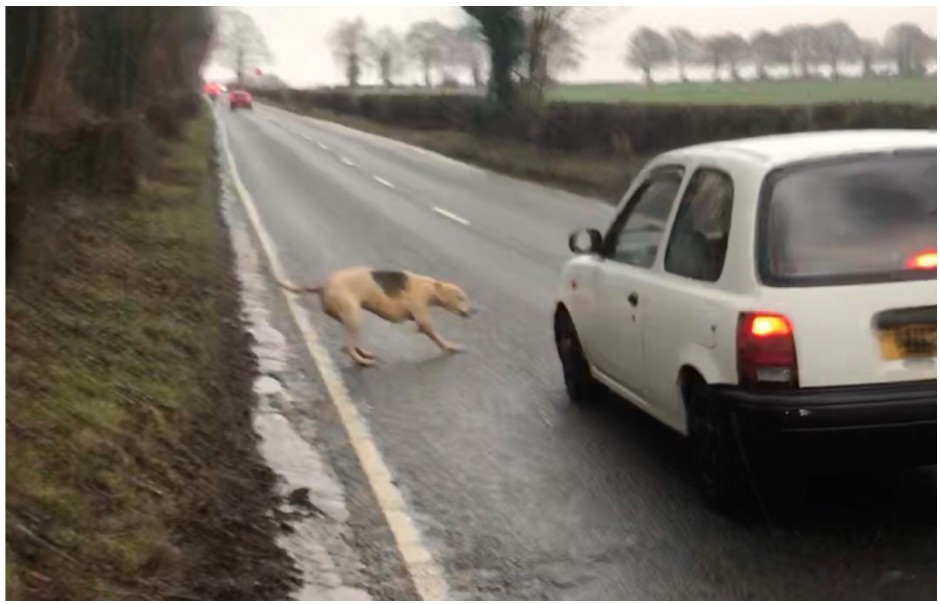
For a video of this on Twitter see here.
A driver cannot help his or her instincts. See a dog run out in front of you, and you will do as he did and swerve as well as brake. If a car had been coming the other way, a very nasty collision could well have occurred.
So whose fault would it have been? Not the driver’s, but the owner of the hound. And that’s because dogs on roads are inherently dangerous that the Road Traffic Act 1988 contains a provision - Section 27, subsection (1) - which makes it a criminal offence to cause or permit a dog to be on a road without the dog being held on a lead.
So isn’t it obvious then, that the owners of hounds which go on roads are committing an offence? Actually, no. As with all legal issues connected with hunting, its not so simple as that. The hunting lobby had powerful friends in Parliament when this Act was passed and they ensured an exception for hunts. It reads: “subsection (1) … does not apply to dogs proved … to have been at the material time in use under proper control for sporting purposes”. Hence it is perfectly legal, whilst out hunting, for a pack of well-behaved hounds to trot along a country lane with the hunt in the classic picture-postcard image hunts like to portray.
But the key words for this purpose are “under proper control”. In what possible sense is a hound under proper control if it is on a public road chasing a fox or deer? In the Morestead Road case, it was such a clear cut situation that the local (Hampshire) police investigated and interviewed the relevant hunt, the Hursley Hambledon Hunt. The matter appears to be nearly resolved with a Community Resolution Order, meaning that the hunt accepts responsibility and writes a letter of apology. Whilst not a conviction, it is a step on that road (if the pun will be forgiven) and the Hursley Hambledon Hunt will have to be much more careful in this coming season, since the next offence would likely mean a caution, and the one after that a court appearance.
The “squeeze”
However, there can be other cases where it is arguably not so clear. The hounds may not be on the road for so long, for example, with the hunt arguing the hounds were in fact under control. This is when what lawyers like to call a “squeeze” can be brought into play.
Consider a case where a hunt is accused of unlawful hunting under Section 1 of the Hunting Act 2004. The defence is invariably of “accident”: the hounds were following a trail when they just happened to come across a fox and chased it. The recent Grove and Rufford and Portman Hunt cases are just two examples. Hounds could not be called back (despite best efforts, of course). Or the huntsman was not sufficiently close to the hounds to be in control and hence responsible. But if the huntsman was not close enough to control his hounds, or was close, but not able to control them, and they cross a road, the Section 27 offence surely cannot be avoided: there is a “squeeze” between the two offences. In order to escape the Hunting Act offence, the hunt is inescapably admitting (indeed positively claiming) a lack of control and hence the commission of an offence under the Road Traffic Act.
Hound exercise
Another activity undertaken by hunts is “hound exercise”. This is in principle an unobjectionable behaviour in as far as the hounds are simply taken out for a run. If only hunting were replaced entirely by hound exercise! However, hounds need exercise every day and it must be a significant effort to put them in a van and drive them to somewhere safe to get this. Hence it’s not surprising that some hunts use roads to access nearby fields.
The question is, does the hunting exemption then apply? The clear answer is “no”. To repeat, the relevant language of the defence is (emphasis added): “subsection (1) … does not apply to dogs proved … to have been at the material time in use under proper control for sporting purposes”. The fact the hounds are used three times a week for hunting is of no relevance to the other four days of the week. There is no blanket exemption for foxhounds. When hounds are being taken out for exercise and use a road they must, like any other dog, be on a lead, or else an offence under Section 27 of the Road Traffic Act will be committed.
Some hunts are worse again and do not even bother to take the hounds to a field. One example local to Surrey Hunt Monitors is the Hampshire Hunt. They’re based in a quiet village called Ropley and here one can often see the entire pack being led around the village roads by three cyclists causing chaos:
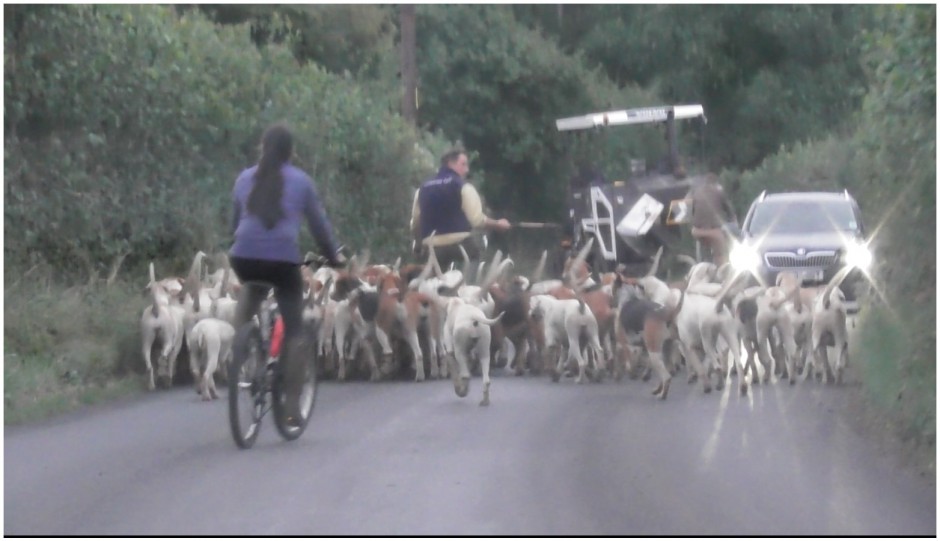
… not to mention depositing a large amount of dog mess …
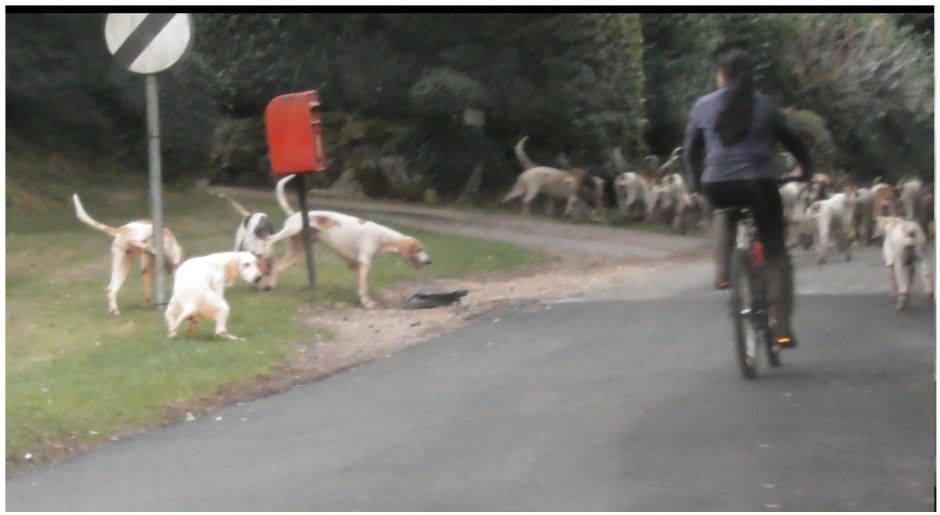
Two sample incidents have recently been reported to Hampshire police, and we await hearing from them as to if and how they intend to proceed.
Advice for Campaigners and the Public
Convictions under the Road Traffic Act are distinctly second best to Hunting Act convictions, but given the difficulty of the latter, they represent a way forward in controlling the reckless behaviour of hunts. So we offer two bits of advice;
1. If you are out early one morning hoping to catch your local hunt cubbing and only see them exercising their hounds on the local roads, dial 101 and report them under S.27 Road Traffic Act 1988. If the police say hunts are exempt, put them straight.
2. On hunt days, when hunt hounds cross a road in pursuit of a fox or deer, report both illegal hunting and the RTA offence and the chances are the hunt will walk straight into the “squeeze”. Let’s at least stop #HuntHavoc before an innocent person is killed in addition to the thousands of innocent foxes who die every year in so-called trailhunting “accidents”. After all, there is #NoExcuse.
© A Surrey Hunt Monitor
5th August 2018
The Fell Packs & #TrailHuntLies in Cumbria
As part of the wider National Dis-Trust campaign which started in Cumbria, we’re adding this to Hounds Off as a reference point for you to learn more about the fell packs, their abuse of wildlife, and why we’re calling for them to be permanently banned from National Trust land. All of the fell packs were either licensed to use Trust land for the 2017/18 season or given free reign to trespass and kill foxes. Here are a few of the ‘highlights’ of their history (click the links to learn more)…
- In November 2017, the Eskdale & Ennerdale Foxhounds were documented trespassing on National Trust land with terriermen, but subsequently received a licence anyway.
- On 06/09/2017, a representative of the fell packs told the BBC that numerous foxes are ‘accidentally’ killed each season.
- At the Peterborough Hunting Festival on 19/07/2017, huntsman for the Blencathra Foxhounds stated that his hounds can sometimes be unsupervised up to five miles away, meaning nobody knows what they are doing or what they might be killing.
- A supporter of the Melbreak Foxhounds attacked a member of Lancashire Hunt Saboteurs on 10/01/2017 who then needed hospital treatment. The hunt supporter was convicted of assault.
- The Melbreak Foxhounds supplied a fake certificate to the Trust dated 23/10/2016 to help gain a licence, and were granted further licences to use Trust land long after the lie was exposed.
- The Melbreak Foxhounds were filmed killing a fox on Trust land by Cumbria Hunt Watch on 05/11/2015.
- On 15/03/2014, the Ullswater Foxhounds were filmed killing a fox before attacking a hunt monitor, resulting in a conviction for assault.
- The Melbreak Foxhounds killed a fox on 09/03/2014 after chasing it across Trust land, resulting in a police investigation resulting in charges and the subsequent intervention of a member of House of Lords trying to defend the huntsman.
- The Blencathra Foxhounds were investigated for illegally hunting & abuse of hunt monitors in 2013.
- On 24/03/2012, walkers witnessed the Coniston Foxhounds killing a fox and police investigated claims that hunt supporters seriously attacked protestors.
- The News & Star reported on 09/01/2012 about hunting forum users allegedly admitting to illegal fox hunting whilst with the Blencathra Foxhounds.
- A supporter of the Coniston Foxhounds attacked a League Against Cruel Sports investigator on 09/03/2010, receiving a police caution.
- The terrierman for the Ullswater Foxhounds was convicted under the Hunting Act 2004 after digging out & beating a fox to death on 26/10/2009, after it had gone to ground. He continued to be employed by the Ullswater Foxhounds, which continued to be licensed by the National Trust.
- The Ullswater Foxhounds huntsman was in court on 17/09/2009 after a fox was killed by his hounds.
- Huntsman for the Coniston Foxhounds was convicted for criminal damage after smashing the windows of a hunt monitor vehicle on 19/02/2008.
- The Blencathra Foxhounds are believed to have killed a fox on National Trust land on 11/02/2006.
WHAT CAN YOU DO ABOUT THIS?
- Ask the Trust’s General Manager for Central & East Lakes firstly why the Melbreak have only been suspended, not banned, and secondly for him to stop offering licences to all fox hunts in Cumbria. His email is [email protected].
- If you live in Cumbria and want to volunteer for our campaign, please email us at [email protected] for packs of leaflets specific to Cumbria to deliver/hand out.
- Sign the Keeptheban petition to ban all hunting on National Trust land in England & Wales.
- Grass up the Cumbrian hunts if you see them by emailing Cumbria Hunt Watch on [email protected].
- Follow National Dis-Trust on Facebook and Twitter for updates.
© National Dis-Trust
10th June 2018
Front Lines #foxylove
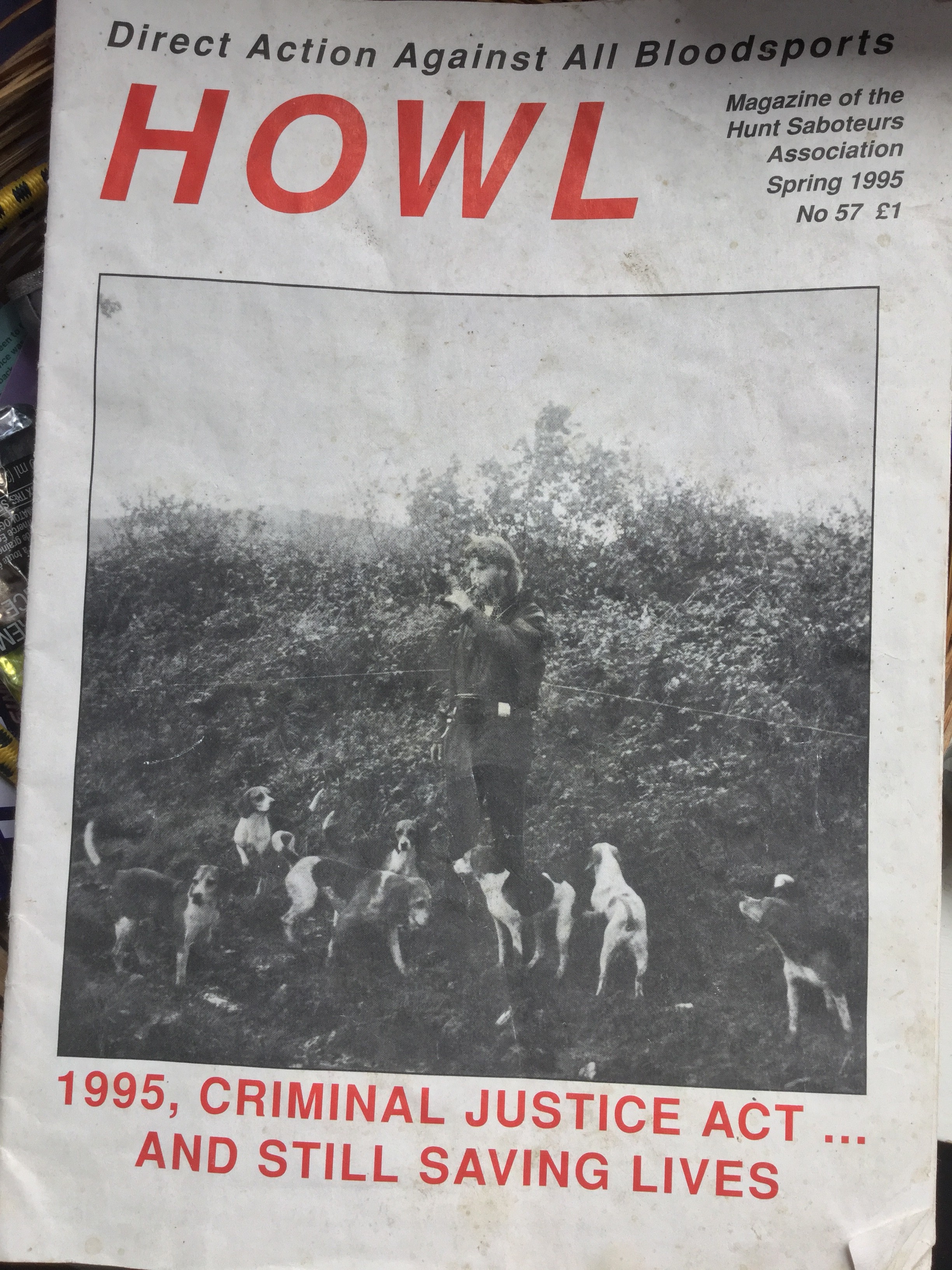 Front cover of HOWL, the magazine of the Hunt Saboteurs Association, Spring 1995, issue 57.
Front cover of HOWL, the magazine of the Hunt Saboteurs Association, Spring 1995, issue 57.
It’s no secret that Hounds Off Founder Joe Hashman is a Life Member of the Hunt Saboteurs Association. Although Hounds Off began existence in 2010, Joe has been an anti hunt campaigner for 36 years. We reproduce here in full his wide-ranging, thought provoking and deeply personal address to the 2018 Hunt Saboteurs Association AGM:
This is the front page of the first HOWL to be published after the Criminal Justice Act was introduced, in 1995. That young man blowing the horn, that’s me. My friend Peter White took the photo with a state-of-the-art waterproof camera while we were doing a two-man sab of the Park Beagles.
The hare had come down a hedge line and turned left-handed through a gate. The pack wasn’t far behind. Pete sprayed some citronella where she turned and I took position on a footbridge over a reservoir. Pete rated the beagles when they checked by the gate. I doubled the horn and gave a few whoops to bring them my way.
We crossed the water and ran along the quiet country lanes south of Yeovil. I was up front in the role of Huntsman, Peter whipped-in from the rear.
After a considerable distance we ran the pack halfway up a hill to a field corner with the intention of finding a barn with a door to put the hounds in. But we couldn’t find a barn so we just held them up and waited.
A long time passed.
Eventually we heard the peel of a beaglers bugle and voice calls in the distance and then realised that a slow a convoy of vehicles was out looking. We relocated downhill to a fast-running brook and slipped into the water up to our necks. Peter and I hid underneath the overhanging bank which was like a flooded cave of mud and tree roots.
We could hear engines, car doors and voices above our heads so we waited for it to go quiet. Then we waited a bit more, and only then did we emerge and clear off. The beauty of that day was that I don’t think the beaglers had a jolly clue what happened and we did completely scupper their hunt.
HOWL was having a poke at those sections of the Criminal Justice Act which were aimed specifically at hunt sabs. Michael Howard was Home Secretary at that time. He dubbed us as “Thugs, Wreckers and Bullies” and was pushing, pushing to bring this law in because we had to be stopped.
Ten years later, the Hunting Act came into force. It was supposed to spell the end of foxhunting and all the rest of it. But thirteen years on here we are, still at it.
On an illegal foxhunt in Dorset last season, some toe-rag, on a quad bike, pulled up next to me within kissing distance and sneered, “Are you a monitor or a sab?”
I was stood alone, in a gateway, filming. The Huntsman was on foot in a small covert across the field. Hounds were marking.
From an inside pocket, my radio crackled a message. I took it and relayed information which guided both sabs and monitors in. Terrier mush contorted his face. “You’re all the fucking same,” he snarled.
Are we all the same?
It feels like quite a responsibility, standing up here and telling you what I think. I don’t want to offend anyone. All I have is experience and ideas. All I ask is that you listen and consider. Everything is up for discussion afterwards. It’s good to talk.
I’m going to advocate engaging with the police. It’s ok to work with them. Not all coppers are bastards.
I’m going to suggest that you might want to consider joining organisations which have not yet banned hunting on their land, so you can raise a Members voice and cast a Members vote.
It’s ok to engage with the system. Sometimes it’s essential.
I challenged a binding over and High Court injunction taken by the Portman Hunt as far as the European Court of Human Rights. It took six years but I won.
I’ve taken two different employers to Tribunal and was successful on both occasions.
First time, a local hunt terrierman was the complainant. That was Unfair Dismissal.
Second time it was a combination of foxhunting, mink hunting and hare coursing which got me the sack. We called that out as Discrimination under the Employment Equality (Religion and Belief) Regulations 2003.
I’ve stood up in court numerous times, for prosecution and defence. Let me reassure you. If you’re honest, have a good case and a team which is intelligent and efficient then using the system against itself can be really effective. It’s not essential to be legally trained.
Just because we’re Hunt Sabs doesn’t mean we have to be outsiders.
My first sab was with the Swindon Group and we did the Old Berks. It was Boxing Day, 1982. My Dad dropped me off at Wantage near Oxford with a placard that said “Fox Hunters Are Scum”.
It was one of those days when we constantly tumbled in and out of a minibus. I watched and listened and learned.
Around mid afternoon, in a field corner, there was a dig. We marched in. There was a scuffle. In the melee a fox shot out and flashed along a hedge. And then another. This fox broke cover and ran into the open for all to see.
The pack was unleashed. We charged into the fray, spraying and rating. We didn’t think twice and we did distract and delay.
Swindon was a good group. They knew what they were doing. I’d like to say we saved the fox but I don’t really know. I was a just a middle class schoolkid. It was my first experience of hunted foxes and mad dogs on cry, thundering horses, flying mud, rural vandals pumped with bloodlust and the thrill of the chase.
Looking back, that was an early introduction to the infamous Three O’Clock Fox. Later investigations revealed an artificial earth in that field corner.
You might have been inspired by photos of sabs with long hair and flared trousers running on to the coursing fields at Altcar, of sabs sitting in badger setts to stop dig outs, or cradling foxes away from danger to safety in their arms.
They say, “A picture speaks a thousand words.” In this day and age, everyone’s a photographer and journalist. Having platforms to convey what happens in the field is a good thing.
Nobody understood this better than Mike Huskisson, and if you haven’t read Outfoxed then you must. He wasn’t the first to expose the bloody truth about hunting, and he won’t be the last, but the timing and quality of the evidence Mike produced, of heinous atrocities against wildlife, moves, inspires, lives on. It was a team effort, of course. Everybody needs support and back-up, but the influence of this work cannot be underestimated.
One thing Mike taught me is that you can be a hunt saboteur in numerous guises. There are many front lines.
********
In the early 1990’s, sabbing the New Forest Buckhounds with interventionist tactics wasn’t working.
It’s true that deer were saved. Anyone who was at one of the many blockades which prevented the Buckhounds leaving their kennels, or delayed them en route to a meet, will testify that we were effective. But our success also made the hunters more determined.
Kill rates went up because deer were chaperoned by outriders, shot on the move and even wrestled to the ground by hunters who were behaving like angry cowboys.
A few of us decided to replace hunting horns and citronella with video cameras, and we turned exclusively to filming. It was controversial. Running with the pack and letting the hunt play out without trying to stop it offended a lot of our friends. But, less than four years after the tactical shift, after centuries of deer hunting in this once-Royal Forest, with a combination of pen and pictures, political campaigning and non violent direct action, the Buckhounds disbanded.
During the passage of what became the Hunting Act there was a option which would have permitted fox hunting under licence. It was late 2002. Tony Blair and others were already wavering. They hoped this Middle Way would provide a satisfactory compromise.
A few months later, the International Fund for Animal Welfare released film of Cottesmore Hunt employees placing fox cubs into an artificial earth. This film exposed blatant flouting of huntings own, self-imposed, rules and exploded the myth of foxhunting as pest control. MPs were outraged and immediately voted, by more than two-to-one, for an outright ban.
The IFAW investigators who took that film were people like us who are still active today.
We can all be proud of the fact that Sabs have always been groundbreakers. We’ve always challenged the Establishment and the System. We’ve always led by example. We’ve paid for it with our liberty, our sanity, sometimes even our lives, but that’s what you do when you believe.
From the moment the Hunting Act came in to force, we’ve called out illegal hunting. But in 2005 who was listening? The press and public had reached saturation point and among our self-appointed leaders and charity bosses the assumption was “Job Done.”
But really, truthfully, did we expect hunters to just stop?
Think about the dogs in your life. How does it make you feel when you see them giving you that pack animal look?
If you’ve been brought up to think of a fox or badger as a disposable plaything piece of shit; if seeing your dog battle scarred but willing gives you pride and social status; if you fancy making a quick £700 on the black market, then of course you’re not going to stop hunting and digging just because there’s a law against it.
Remember how we reacted when they tried to stop us with the Criminal Justice Act?
So, thirteen years ago, the question was whether to sab, gather evidence or do both?
The first case went to court within months and once again, it was on evidence gathered by one of our own.
Exmoor Huntsman Tony Wright was convicted but he appealed and was acquitted. Worse still, the Appeal Judge ruled that searching for a fox was not covered by the term “hunting” as defined by the Hunting Act.
I’d love to know why that ruling wasn’t challenged, but it wasn’t. So the early stages of a hunt which we all know as “drawing”, is not illegal. At a stroke, enforcement got harder.
Loads of cases failed because of corruption, police and prosecution ineptitude, and loopholes which were inserted to protect the tally-ho brigade.
Hundreds of poachers and lurcher boys have been done, but precious few from registered hunts.
It took ten years before well-paid, professional, anti-hunting charity bosses were prepared to echo, publicly, what we had been banging on about that whole time - that the Hunting Act is chronically flawed and needs reinforcment.
But by then, the RSPCA had been destroyed as a campaigning organisation. In 2012 they took a courageous private prosecution against the prestigious Heythrop Hunt, based on evidence gathered by people like us.
They achieved a groundbreaking conviction. The Heythrop Hunt Limited admitted illegally hunting foxes. This meant the Hunt itself was guilty and not just an individual. That was important because servants can be sacked or retired and then claims made to be sweeping clean with a new broom. Getting done as a Corporate Body cut much deeper.
Despite being one of Englands richest, most prestigious packs, hunting foxes four days each week and drenched in privilege, the Heythrop Hunt and two staff members said that they pleaded guilty because they couldn’t afford to contest the case.
And the Countryside Alliance went into attack mode. They assassinated the motivation and reputation of our leading animal welfare charity with venom and fire.
Soon the Chief Exec was suffering from ill health, there was widespread internal restructuring and the RSPCA dropped their commitment to take Hunting Act prosecutions.
For a while hunts adopted pleading guilty on the grounds of saving taxpayers and charity donors money but a rash of convictions gave the Hunting Act statistical reinforcement.
So they changed tack, aiming instead at scuppering cases on technicalities surrounding evidence handling and witness reliability.
The League fell foul of these tactics during their 2015 case against the Lamerton Hunt in Devon and then they also pulled out from taking prosecutions.
IFAW had invested considerably in its Enforcement Team and achieved some notable successes. In December 2015 they published a report called Trail Of Lies which analysed, deconstructed and exposed how hunts throughout England & Wales are circumventing the law.
And then, six months later, IFAW dismantled their Enforcement Team. Bosses would say that they were channeling funds at worthy animal causes elsewhere in the world.
So I think we should take our hats off to sabs everywhere but especially from Beds & Bucks and South Cambridgeshire for being there and gathering evidence in the recent Fitzwilliam case. It’s the only standing conviction of a registered pack under the Hunting Act since Trail Of Lies was published.
The Countryside Alliance love playing the oppressed minority card and spinning all sorts of lies and bullshit. We shouldn’t blame them because this is a war and, whilst they’ve been very bad at getting the Hunting Act repealed, they have been pretty good so far at dodging and disabling it.
Not long after the Hunting Act came in to force I took part in a sting on the Palmer Milburn Beagles.
A friend and I pretended to be four-wheel drive nutters. We set it up so that one Saturday we chanced upon the beaglers during the course of green laning adventures on Salisbury Plain, and then went from there.
For two months we compiled a written and video dossier on the Palmer Milburn which showed consistent illegal hunting.
Unfortunately, it was a matter for the MoD police and the officer in charge knew nothing about the subject or how to apply the law.
So we filmed hares being found, hunted, lost, refound, hollered with voice and raised caps, hunted by scent, hunted by sight.
But the investigating officer didn’t understand that hunting is the crime, you don’t have to kill to be guilty. His entire investigation focussed on the one kill we did film, at distance in rough grassland.
It’d been a long hunt in poor weather. The hare was exhausted and had clapped. Huntsman was letting hounds cast themselves in the vicinity.
We were parked next to the Whipper-in, one of us out of the vehicle watching and chatting, the other filming discreetly from a window.
All of a sudden the beagles dived into a scrum amid a crescendo of noise. Huntsman bounded towards them and blew for a kill. We even recorded the Whipper-in saying, “That’s a kill. Don’t tell anyone I said that, it doesn’t happen.”
The investigating officer received our dossier and had six months to lay charges. But with one week to go he called a meeting and told us there was insufficient evidence.
He told us that, under caution, the Huntsman claimed they were not killing a hare. It was the beagles pouncing on a packet of biscuits he’d hidden to reward his dogs at the end of the trail.
Because of the long grass, poor light and the fact that this hare was knackered and chopped, we couldn’t prove the utter piss-taking nonsense of this lie.
Acting on information received, we did a job on the Tynedale in Northumberland. We’d drive through the night, have coffee and a detailed briefing with our disgruntled ex-hunt servant contact, then get to work.
The Tynedale own a notorious fox cover called Beukley. We trained hidden cameras on badger setts which pepper its craggy lower slopes and got footage of earth-stopping. And we repeated this in other locations.
Northumberland police were willing but the CPS refused to let the case go to trial because they questioned whether the setts were active.
We had hair, prints, a range of accepted field signs and confirmation by a local badger expert but the CPS insisted on evidence that was practically impossible to achieve.
Before he was Prime Minister, David Cameron pulled strings for his Heythrop chums. Again, we became trusted hunt supporters and filmed lots of illegal hunting over a period of many months.
We produced another compelling dossier and the coppers were on board. It had gone up to the CPS and then, out of the blue, the case dropped dead. No explanations, it just stopped.
It wasn’t until publication of Lord Ashcroft’s book “Call Me Dave” that what happened was revealed - influence had been exerted over the heads of Gloucestershire Police by the Conservative Party leader. Once again, justice wasn’t done.
********
The Hunting Act is weak but not completely flawed.
It used to be, around the end of every February or early March, a three day event was held in Lancashire called the Waterloo Cup. It was the pinnacle of the hare coursing season, considered by aficionados of the sporting greyhound to be its ultimate test.
Canine speed, agility and stamina would be scrutinised by putting in front of them a live hare. Greyhounds were released in pairs, scoring points for how quickly they ran up to their quarry and their skill in working her at every twist and turn.
Publicly, coursing supporters would say that the object was to exercise not kill the hare. But from the crowds at Waterloo, which sometimes numbered thousands, cheers and celebrations were loud and drunken when she was snatched, “bowled over” or clamped, screaming between the jaws, tragic and doomed, a living tug-of-war rope. The Judge on horseback awarded points for that, too.
This was a knock-out competition starting with 64 entrants. Winning greyhounds progressed until one victorious dogs trainer got awarded the Waterloo Cup itself, loads of money and legendary status in the history books.
There was a Plate Event for losers and side shows. Many hares were needed and had to be imported regularly from East Anglia to keep the population artificially high.
Hare coursing was well organised by different local Clubs. Weekly meets were held across England and Scotland from September to March under rules stipulated by the National Coursing Club.
Then the Hunting Act made it illegal. But, just as foxhunters invented trailhunting as a false alibi, so hare coursers rebranded their sport as ‘Greyhound Trialling’.
On 2nd and 3rd March 2007 I found myself in Yorkshire, working undercover to expose the myth of Greyhound Trialling at a two-day event being billed as the New Waterloo Cup. We knew that there had been numerous similar, smaller events throughout that winter and this was the culmination of efforts to facilitate the reintroduction of hare coursing.
My partner wore a pinhole camera. I had a camcorder wired into binoculars.
On arrival we could see people away in the fields beyond a belt of trees, waving plastic bags on sticks, working as ‘beaters’. There were lots of vans with greyhounds being tended and prepared.
Just out from the field edge was a man standing in a three-sided shelter, wearing the traditional red coat, holding a pair of greyhounds on a leash. Hares were being shepherded, manoeuvred to run, one at a time, from behind the shelter into the area in front and in view.
Greyhounds would be straining now and slipped from their long leads. The sprint was on. Parallel lines of people stood in the field to scare the hare back towards the middle whenever she tried to break free to the side.
This was all entirely consistent with pre-ban hare coursing run under National Coursing Club rules.
But there were a couple of subtle differences. First, the greyhounds were muzzled. We didn’t see any hares get savaged although we did film them pinned and pummelled before men wrestled them away and pulled their necks.
Second, there was a man with a gun who, according to the law, was supposed to shoot hares which had been ‘flushed’ beyond a stretch of orange plastic barrier netting. He only ever discharged his gun into the air, to laughter and ironic applause, and the netting was both unfit for purpose and often in entirely the wrong place.
Organised hare coursing is covered by Section 5 of the Hunting Act, which is unequivocal. It states, “A ‘hare coursing event’ is a competition in which dogs are, by the use of live hares, assessed as to skill in hunting hares.” There is little wriggle room for people who get caught.
The upshot of our undercover operation was that two landowners were found guilty at Scarborough Magistrates Court of hosting the illegal event. Subsequently, celebrity chef Clarissa Dickson-Wright and racehorse trainer Sir Mark Prescott bowed to a private prosecution brought by IFAW. They pleaded guilty.
Although Dickson-Wright made the headlines, it was Prescott who was a lynch pin of the coursing world. He had revived the original Waterloo Cup in its later years when it seemed to be dying a natural death.
At around that time we secured convictions against organisers and landowners who facilitated and attended a so-called ‘Greyhound Trialling’ event in Norfolk. Together, these operations signalled a victory for the Hunting Act (Section 5) and the end of organised Club Coursing - unless you know otherwise….
*******
In 2013 Owen Patterson was the Environment Minister. He was presented with a research paper by the Federation of Welsh Farmers Packs which claimed that using two hounds to flush foxes to guns was inefficient and inhumane. Patterson joined the chorus of hunt supporters seeking amendments so that using a full pack to flush would be legal, as in Scotland.
For a while it looked likely that the Conservative-led Coalition Government would pass the amendments and the Countryside Alliance was licking its lips in anticipation. In fact, the Federation of Welsh Farmers Packs was a front for the CA itself.
Thankfully not everyone was so crooked and bent. Within DEFRA itself there were misgivings.
The Welsh Farmers paper was flagged as containing incomplete data, inconsistencies, statements at odds with its own evidence and being neither peer-reviewed nor published.
I’m told it was a refusal to budge by Deputy Prime Minister Nick Clegg which finally saw this sly effort dropped.
Do you remember July 2015, when Parlaiment was about to be suspended for the summer holidays? Tories had just won a majority and had another stab at back-door repeal. They proposed amendments which were presented as minor and just bringing England and Wales into line with Scotland.
But hunt supporters underestimated how much the public still dislike ritualised animal abuse. If they thought they could undermine the Hunting Act (and democracy) quietly, unnoticed and with little resistance, they were spectacularly wrong.
Millions of us protested our disapproval. We lobbied our MPs. We spoke, wrote, tweeted, retweeted, shared, liked, favourited, pinned, posted, demonstrated, reported, advertised, sang, shouted and dreamed about defeating these amendments and the dark forces behind them.
Key to saving the Hunting Act was MP support. Hunters claimed the Scottish National Party scuppered those amendments but that’s not true. Actually, an irresistible coalition was mobilised, comprising MPs from across political parties and Home Nations who all committed to defending the law.
Hunters lost their nerve. The day before the scheduled vote the amendments were withdrawn.
Remember last year, that surprise snap General Election? Polls predicted “The biggest Election win for decades”. And Brexit wasn’t the only thing on people’s minds….
The Daily Mirror published news of a leaked email from Conservative Peer and foxhunting fanatic Lord Mancroft, urging Hunt Masters to mobilise their supporters and campaign for pro-hunt Tories in marginal seats. He reckoned that an increased majority of 50 in the House Of Commons would be enough to overturn the Hunting Act.
To be honest, Mancroft only confirmed what we already knew.
Bloodsports organisations have always worked hard to get their own people elected.
Vote OK is the baby of Lord Ashcroft, another Tory Peer with disproportionate money, power and influence. Manpower and resources get poured into marginal constituencies where they think they can get pro-hunt candidates elected.
Vote OK channels the energy of local Hunt Supporters Club members and offers them up as campaigning foot soldiers. The deal is that the candidate must accede to their single-issue fanaticism and promise to vote for repeal of the Hunting Act.
In his email to every Master of Fox Hounds, Lord Mancroft wrote, “This is the chance we have been waiting for.”
The day after the Mirror exposé, the Prime Minister took questions from factory workers in Leeds. Until then, questions put forward on the campaign trail had been screened in advance and answers prepared. In Leeds TM the PM was speaking unscripted.
When a man asked if there was truth in rumours that Tories would make bloodsports legal again, Teresa May replied, “As it happens I have always been in favour of foxhunting.”
We campaigned bloody hard after that, didn’t we? Especially in places like Wrexham.
For loads of reasons the Tories divebombed. They’ve even dropped their pledge to repeal the Hunting Act during the life of this parliament.
It’s a massive shift.
Remember, the Countryside Alliance used to be called the British Field Sports Society and the BFSS was widely known as “The Conservative Party At Play”.
The hunters goal is to destroy the Hunting Act and future-proof bloodsports. And the next big threat is Brexit.
If all goes to plan, masses of European law and EU Directives will be changed into bespoke British legislation. The Countryside Alliance have sussed that it’s here where they can stick in their oar and influence things so that these new laws will simply supercede the Hunting Act. There’ll be no need for repeal.
Last year the CA produced their own Brexit Policy Document, and they aimed it at MPs. They barely mentioned hunting but this thing called “wildlife management” played big.
Now they’ve published their Brexit Rural Charter. There’s a whole section on wildlife management and hunting with hounds is pitched as an integral part of this.
The principal of hunting with dogs is being normalised and detoxified with rose-tinted promises of self-regulation and words like sustainable, environmental, natural, conservation, humane, even animal welfare.
I believe that the CA has taken its lead from America. Over there, hunting, shooting and fishing are administered at local level by official bodies which “manage” wildlife populations via licences, quotas, regulations. What happens on the ground is state-sponsored animal abuse on a mind-boggling scale but it’s sold to the public as practical, sensible, wholesome and good.
I hope I’m wrong but, as things stand, it’s on the cards for an American-style system of administrating bloodsports to slip-slide onto the statute books as EU Environmental Directives and Laws are replaced with UK-specific legislation.
This is complicated politics. The question is, do we, as a movement, have the vision, experience, skills and will to get our heads together and avert this car crash before it happens.
And it’s not just MP’s being hoodwinked by hunters. They’ve been grooming children for generations because an ongoing supply of willing participants is essential for the continuity of deathsports.
A vital part of the infrastructure which traditionally leads horse loving youngsters into the dark world of killing-for-fun are the Pony Clubs, most of which are linked with mounted hunts and, so long as these hunts claim to be trailhunting within the law, they’re able to mislead many impressionable youngsters (and their parents) about their real intent.
With a range of horse-related activities on offer which seem a million miles from the ritualised sacrifice of a fox, hare or deer, Pony Clubs provide a perfect gateway for introducing children into the ways of the Hunt.
Trail Hunting is nothing more than a charade which provides a perfect cover story for grooming the young and the the gullible, especially when days are tailored to enhance the illusion and the messaging from respectable adults, supporters clubs, hunts themselves and their representative organisations all conspire to convince impressionable young minds that Trail Hunting is legitimate.
By the time the awful truth dawns it’s no longer seen as awful. To the next generation of deathsport enthusiasts, indoctrinated into a world of false alibis, blind eyes and rural lies, wild mammals which are illegally hunted and killed are no longer empathised with; reduced instead to objects of amusement, to be besmirched and abused, accidentally or accidentally-on-purpose, depending on who’s looking or asking.
Did you know, a few years ago the Countryside Alliance Foundation created a whole suite of teaching aids aimed at primary school kids called the Countryside Investigators?
Countryside Investigators branding is bright and appealing. But it’s a confidence trick. Scratch the surface and Countryside Investigators is just another tool for grooming children with pro hunt propaganda.
We shouldn’t be surprised that the Kimblewick were grooming inner city youngsters in South London a few weeks ago, because it’s all part of their master plan.
*******
This is the point where I was going to tell you about a hunting atrocity which happened in a private garden. But I can’t, and the reason I can’t is that the person who Hounds Off is supporting is so frightened of upsetting the local hunting community that she doesn’t want the incident to be identified. It’s isolated where she lives and her worries are genuine.
So let me tell you about staghunting on National Trust property instead.
Back in the 1990s, the National Trust commissioned a Cambridge University Professor of Animal Behaviour to conduct a two-year scientific study into the welfare implications of staghunting. It was in response to a Members Motion at an Extraordinary General Meeting in 1995. Members voted overwhelmingly for such a study. It was truly independent and both Westcountry staghunters and the League co-operated.
Professor Patrick Bateson and his team shadowed the Devon & Somerset and the Quantock Staghounds. They observed and then took blood samples from sixty-four hunted deer at the point of death. In the lab the samples were analysed and tested. They were contrasted and compared with similar samples from deer that were shot.
Bateson’s report was published in 1997. The extent of suffering and cruelty caused to deer killed by hunting with dogs was proven to be so profound, so extreme, so beyond anything which might be experienced in nature, that it shocked everyone. The National Trust immediately banned staghunting on its land.
Next day, The Daily Telegraph headline was, “Death Knell Sounded For Staghunting.” But sadly, it wasn’t.
After a short period when the hunting community hung its head in shame, they came out fighting. They rubbished Bateson and his methodology and did their own, quick, pseudo-scientific study which concluded that Bateson was wrong and that staghunting wasn’t really very cruel.
Consequently, staghunting never stopped. And for me the scandal is that for twenty-one years the National Trust have failed to enforce their own ban.
Just take the situation on the Quantock Hills. It’s a compact area with some very large blocks of National Trust land. Technically, the Quantock Staghounds are not allowed to go there. They have no licence for so-called “exempt hunting”. But they do, frequently, because that’s where hunted deer take them. National Trust Wardens don’t stop them because they say the boundaries are so big and remote that they just can’t be in the right place at the right time.
There are similarly large blocks of Forestry Commission land from which staghunting is also technically forbidden. Without the Commission and Trust acres, the Quantock Staghounds would struggle to operate two days a week for eight and a half months a year. They’ve already taken extra country on loan from the Devon & Somerset to remain viable.
What do we do about this? Direct action, monitoring and evidence gathering, political campaigning or a combination?
One thing I feel strongly about is if you can afford to become a Member then join the National Trust. I know many have left in disgust after last years Members Resolution to ban trailhunting was scuppered by the Ruling Council but the simple fact is, since then, overall membership has gone up because there’s been a massive influx of hunt supporters joining. Ever since The Bateson Report, they’ve been trying to take over the National Trust. Cancelling or refusing membership might give you some personal satisfaction but as a campaigning tactic it is flawed.
The National Dis-Trust was started by people like us, and has done sterling work over recent years. 618,000 acres and the viability of many hunts are at stake so it’s really worth thinking about the most effective ways to best protect animals from cruelty.
*******
Hounds Off offers a way to stop hunting even if the Hunting Act gets repealed or superseded.
I’ve told previous AGMs about how we help, support and advise beleaguered landowners, about saving lives, making friends and influencing people. These things remain the core of what we do. But Hounds Off is evolving. We’ve now got solicitors and barristers supporting landowners from Devon to Cheshire to Sussex and we are developing real teeth.
And because havoc and trespass incidents are inevitable consequences of illegal hunting, we work with the police.
Nobody likes being treated like a fool, including officers of the law. Remember, beneath the uniform, they’re people too, and there are many who are fucking well fed up with illegal hunting.
It’s not easy to break down cultural and political barriers. It takes time, patience and energy to dispel negative stereotypes, to earn trust you never had. It can be a thankless task but we’re doing it and we’re doing it for the animals.
If hunting is ever going to really stop we must connect with people in a positive way. We’ve got to reach and touch the hearts and minds of ignorant, arrogant, addicted, thugs, wreckers and bullies so that they wake up one morning and think, you know what, I don’t want to abuse and kill animals any more. And these people need to pass on this new way of thinking to their children.
I always ask myself, what would I do if I was them? I know that if I was a nasty bastard and felt assailed or mocked by anti’s, I’d go out and abuse more animals for longer in their name as vengeance.
For me, sabbing has always been about spreading love not hate. I’m not deluded. I know we make people angry. But I don’t think that rubbing people’s noses in it is a good idea.
In February, I was driving with a friend to a pop-up demo at a Mendip Farmers meet. We were chatting and she asked, when did I stop being a Hunt Saboteur? I said I haven’t, I just do it differently these days.
*******
Remember that lad on the quad bike I mentioned at the start? Maybe he was right. Maybe, fundamentally, us lot here today are the same…
Because there is something. There is something that makes us devise crazy plans that might just work, something that gives us strength to roll with the knocks and stand up again in defence of wildlife in difficult and often dangerous conditions.
Lots of people care, and care genuinely. But what is it, what is it that moves you to put your neck on the line in service of our humble brethren?
© Joe Hashman
1st April 2018
But….They Say They Only Hunt Trails
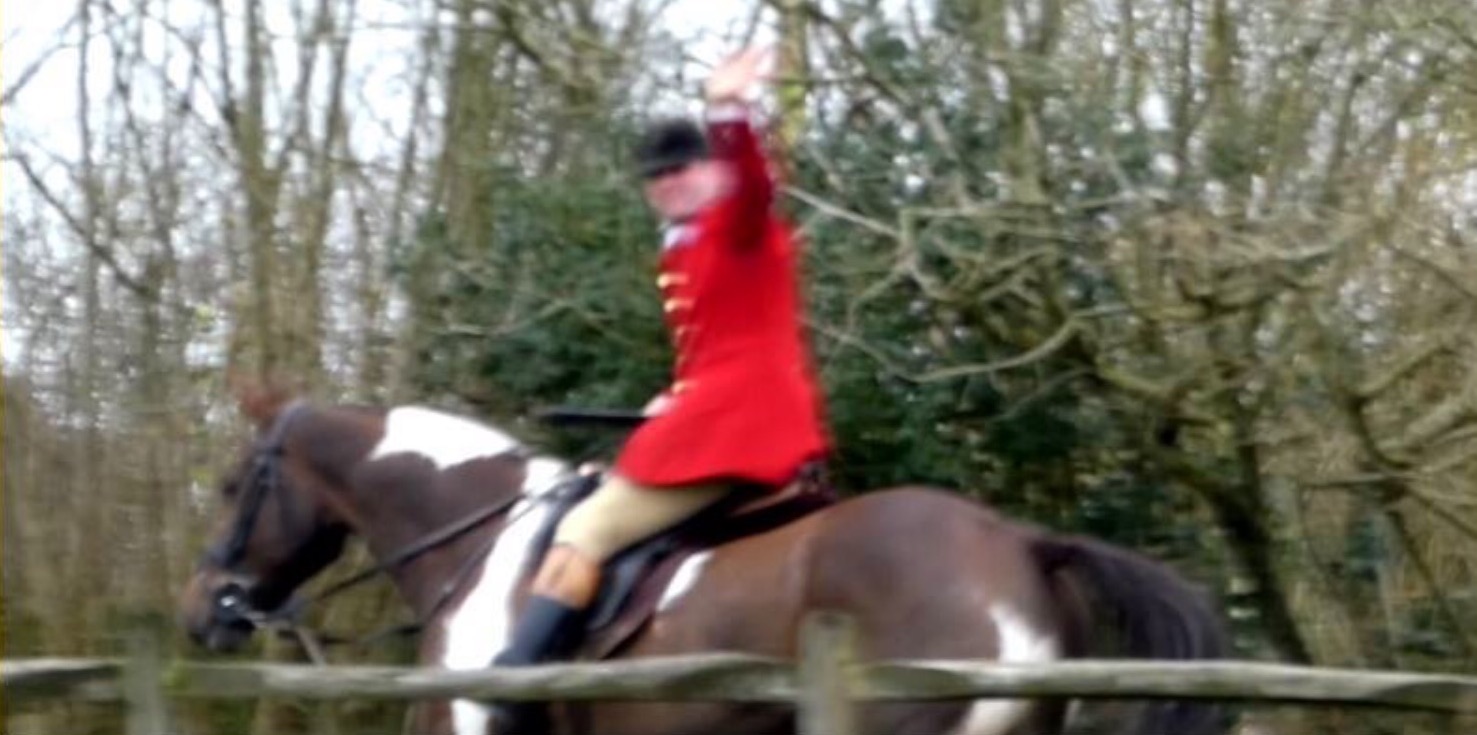 Huntsman of the Eggesford Hounds waves sarcastically at landowners who want to keep him and his hounds off Wheatland Farm in Devon (who took this pic on 30.03.18).
Huntsman of the Eggesford Hounds waves sarcastically at landowners who want to keep him and his hounds off Wheatland Farm in Devon (who took this pic on 30.03.18).
Hunts do not always respect landowner wishes. Often people ask the local hunt to keep staff, followers and hounds off their property but then it happens - again. You need patience, stamina and strong support to stand up for yourself.
Sadly hunt trespass is all too common still. Hounds Off currently supports loads of people who are bemused at the attitude and arrogance of repeat offenders. In the instance below we are also asking ourselves, “But if they chase man-laid trails with dogs that are under control, like they say they do, then how come the Eggesford hounds were running all over forbidden land for the second time this year?”
Eggesford Hunt on Popehouse Moor Again: Wheatland Farm, Devon 30 March 2018
Are you troubled by the hunt? Contact Hounds Off
© Joe Hashman
23rd January 2018
Providing Support For Those In Pain & Distress
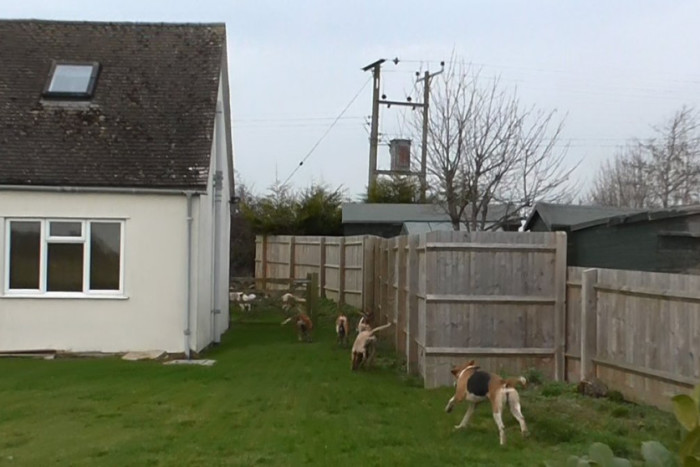 Hounds from the Warwickshire Hunt running out of control in Oxhill near Banbury. Pic credit: West Midlands Hunt Saboteurs
Hounds from the Warwickshire Hunt running out of control in Oxhill near Banbury. Pic credit: West Midlands Hunt Saboteurs
Last week we met a woman who had a foxhunt invade her property. She was still raw from the experience and visibly upset when telling us about it.
The local hunt was in the area and had let their hounds run loose on the scent of a fox. The fox ran into private woodlands with the hounds in hot pursuit. A herd of deer in the woods distracted the hounds and they split up to chase the deer in all directions, then cats, a dog and a goat. The woman and her friends were minding their own business just getting on with their day. Then this bedlam descended, literally, upon them. There weren’t enough broom handles or people to cope and anyway, the hounds were only interested in hunting.
This was no fleeting stampede. It took over an hour for the Huntsman to gather and remove his dogs. By then the police had turned up and were also helping. Two weeks later and six cats are still missing, presumed dead. The others are nervous, shy, frightened. It will take time and tlc to recover their confidence.
The woman was traumatised. She shook as she talked. Her eyes welled up when she described how the peace and tranquillity of her sanctuary exploded with animals running left, right and centre when about twenty-five foxhounds in full cry descended the valley with no warning. She expressed surprise at how big the dogs were and shock at seeing a fox flash past at great pace, running for its life. We explained that, actually, hunts across the land are breaking the law. All the hunters have to do is claim it was an “accident” and they get away with it. She now knows first hand the reality of #TrailHuntLies.
Hunt trespass can have a profound effect on people. It traps some in their homes, fearful to go out on certain days of the week in autumn and winter because they never know if the hunt is going to come crashing through their place. That is no way to live.
Imagine stepping out of your back door and being almost knocked over by rampaging hounds, then having someone sat high up on a horse shouting down at you and gesturing to open your gate so they can come in and fetch them. This actually happened in Dorset and now we keep in close contact with the woman and local police. She is clear and so are we - there must never be a repeat of this.
A young mother who had foxhounds come into her kitchen told her local newspaper, “I am shaken and beyond furious. I can’t bear to even speak to the hunt master who obviously thinks that my home, a haven for my children, is fair hunting ground for their hounds to come and go freely with complete disregard for the safety of my children.”
We watched with interest the evidence of terriermen following a hunt in Devon digging out a fox which hounds had run to ground on Saturday. To most right-minded people it’s an open and shut case but we’ve noted the terriermen’s excuse that they did not intend to kill the fox and were merely rescuing their dog. Without doubt they’ll lay that on as thick as possible and trust in the police to do less than a proper job. It grieves us to write that Devon & Cornwall Police have form. Despite this we’ve helped a number of disgruntled locals who have reported trespass and intimidation by the self-same hunt this last fortnight. We always advise involving the police at the outset, firstly by reporting anything which makes you feel concerned or unsafe and secondly, by cc-ing them in to all correspondence. We always live in hope to be pleasantly surprised.
We’ve been having a conversation with woodland owners in Somerset since December. They’re fed up to the back teeth of having the local hunt ripping through their land and terrorising its human and non-human inhabitants. We’ve arranged to meet later this week. So it was wonderful to receive an email from our contact this morning with details of three neighbouring farms who want to keep hounds off their vast acreages too.
January is always a busy month. We believe this is because it’s the fox mating season. Dog foxes are on the move in search of love. Their wanderings frequently take them far away from of their familiar, home patches. A hunted fox will instinctively bolt down a hole but hunts block all underground refuges and so the fox is forced, against its natural instincts, to keep running. Hunts deny this, of course, but we know the truth.
The above is just a snapshot of what we have going on right now. If you’re affected by hunt trespass or know someone who is then please, contact us. Hounds Off will support you. You are not alone.
You can support our work by or buying some Hounds Off merch. Please consider it. We are all volunteers and cannot survive on goodwill and fresh air alone!
© Joe Hashman
5th January 2018
The Politics Of Hunting (free event): Tues 9 Jan, Alton, Hants
Questions & queries via our Contact Us page or social media platforms. Thankyou.
6th December 2017
On Campaigning In The Back Of Beyond
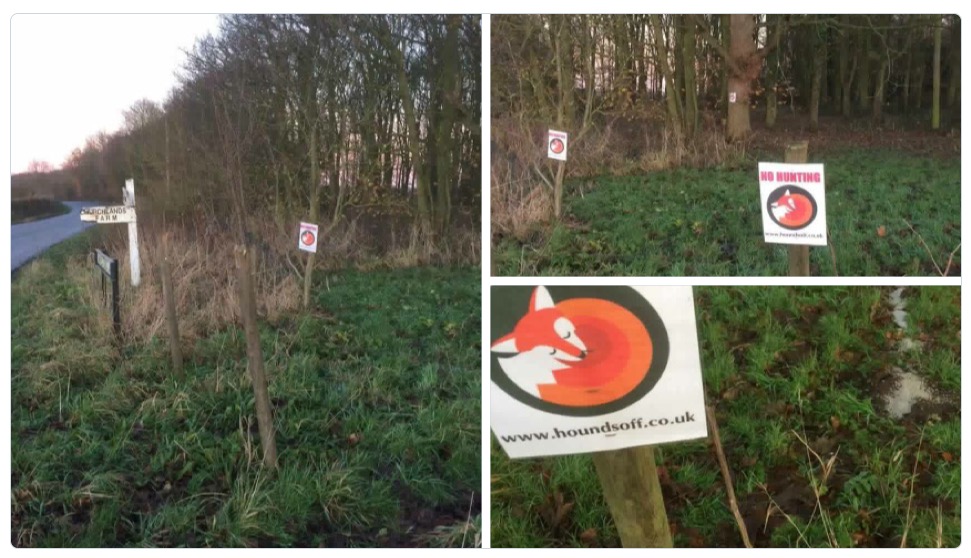 Hounds Off 'No Hunting' notices lined the routes to the Holderness Hunt meet at Churchlands Farm, Winestead, East Yorkshire, on Tuesday December 5 2017.
Hounds Off 'No Hunting' notices lined the routes to the Holderness Hunt meet at Churchlands Farm, Winestead, East Yorkshire, on Tuesday December 5 2017.
Lynn Massey-Davis contacted Hounds Off when she heard that the Holderness Hunt was meeting in the next village on 5 December 2017. We helped Lynn to spread #foxylove around her neighbourhood before, during (and after) the suspected illegal hunt. She wrote this blog for us to share and, hopefully, inspire;
I live near Hull and there are many things I am grateful for in my life and one of those things is my love of wildlife and respect for living things which brings me more joy than I can express. The two people I hold responsible for inspiring me on this course are my dad, Bill Massey, a lorry driver and Sir David Attenborough, one of the greatest naturalists of all time. It is these two men, plus one other who inspired me to lead a single-handed campaign against the Holderness Hunt who met in Winestead yesterday, close to where I live.
When I found out the hunt were meeting here I went online to find out if there were any local groups who could help me make it unscomfortable for them and deter them from coming to my patch ever again and there were none. It was hardly surprising, Patrington where I live is 16 miles the wrong side of Hull and no one wants to travel that far, ever! That is why our landscape and wildlife heritage is so wonderful. We have foxes, badgers, owls and even albino hares. As birdwatchers know too, we have the best views available of migrating birds every spring and autumn.
The people too are pretty spectacular – characterful, quirky, old fashioned but independent and free spirited, who love the fact that few fashionable people venture this far.
Being almost alone what could I do? It was unsafe to monitor the hunt directly, but I could still fulfil the main aims of my campaign, to make my opposition to hunting and concern for wildlife known. You too can achieve something even if you are just one. So here, are some ideas for a lone campaigner against a hunt:
Use the internet
We hear so much about the evils of social media, but this is a chance to use it for good. I connected with every anti hunt group I could. Now there are some of them who express their feelings there in a way I wouldn’t choose to myself to be sure, but they are a mine of information and support. It was on Facebook that I found Hounds Off and received masses of helpful guidance.
I also sent emails to the RSPCA, our local wildlife trust and our local newspaper.
From the comfort of my study I researched useful information such as details about the farm where the meet took place and found out that it actually belongs to the Church of England. This made me think, can the church as landlords and one of the biggest land owners in the country be persuaded to do what the National Trust failed to do? My thinking on this is still a work in progress so watch this space…
Use the traditional media
I created a police log where I recorded my concerns that in an area full of wildlife the Hunt were almost certain to break the law. I then wrote a letter to our weekly newspaper explaining how people could report the Hunt using this log number. It was printed and loads of people found me and expressed support.
Write letters
As the advice on this page suggests, emails and letters record your intent. I put the hunt on notice and my letter has been passed around as a template to other groups so that they can use the form of words which are factual, cool and yet firm. I must have rattled them since it came back to me that they had distributed my picture to the followers. Naturally I was concerned so I told the police.
Raise Awareness
At the weekend I printed off and laminated about 50 signs to put around the area. I took someone with me as a witness and to make me feel secure. We asked people if we could put them up on their land. We put up dozens and people were so grateful to me and my staple gun. Of all the people we asked we only had 3 refusals and the aggression which two of them showed was all on their side. I was resolutely polite – you do get an amazing view from the moral high ground.
Schools, colleges public bodies, allotment societies and businesses are often supportive and may give you permission to put up signs in their property. But learn from my mistake, put the signs well inside fences or the hunt followers may tear them down.
I don’t know whether my actions and those of my two helpers saved any foxes yesterday but as they say, Rome wasn’t build in a day. I’m in this for the long haul.
I began this blog by saying I have been inspired by my dad, Sir David and one other. The one other is William Wilberforce born in and later MP for Hull. He didn’t give up easily and spent his whole life campaigning against slavery to win victory as an old man. As I am a descendant of Preacher John Newton, one of Wilberforce’s collaborators I can think of no better guide on this journey. One-day justice will prevail.
© Lynn Massey-Davis
Lynn is a teacher and freelance writer who has lived in Holderness for the last 25 years. She has a family and too many animals and her favourite species of animals are wombats.
28th May 2017
The Magic Of Hares
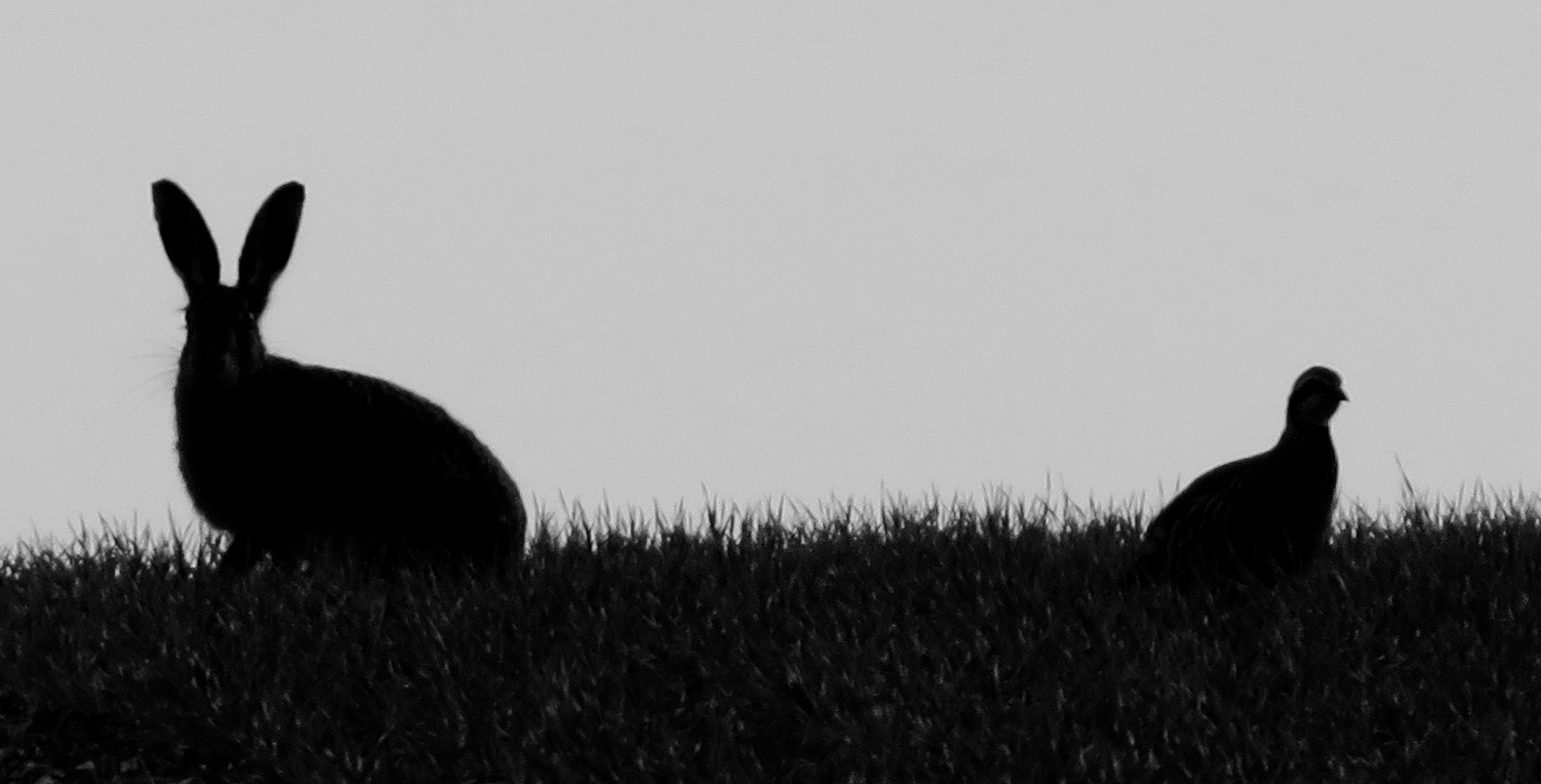 Hounds Off is grateful to Brigit Strawbridge for her permission to use this 2017 photograph.
Hounds Off is grateful to Brigit Strawbridge for her permission to use this 2017 photograph.
The Hare Preservation Trust invited Hounds Off Founder, Joe Hashman, to write the The Magic Of Hares to mark the occasion of their 2017 Annual General Meeting & HareFest which took place at Aldeburgh in Suffolk on Saturday 28 May:
THE MAGIC OF HARES
It’s hard to know how to properly explain what I think about hares.
It’s not enough to say, “They’re amazing creatures, magical, beautiful, I love ’em, look at their ears, those legs, you wanna see them moving, they’ve got wild eyes.” Words don’t adequately convey my feelings towards hares, or how they pull on my heart strings and stir emotions which always feel deep.
I do love hares. I love hares that I see doing their thing in passing fields beyond the windows of a car, I love hunted hares which I worry about and desperately want to escape, and I love all the hares in between.
My first encounter with a live hare was when I was in my early teens, while travelling on a West Oxfordshire backroad to play an evening tennis match. She was large and upright, poised on the tarmac ahead, then gangly but strong, powerful, poetic as she ran.
It was a straight and open stretch of single track lane so we were treated to an extended view. My Mother slowed to an appropriate speed so we could safely but closely see this almost unbelievable creature. Then, in a bound, she was gone, jinking right-handed into the luxuriant verge.
This hare made quite an impression. In that moment her species lept off the butchers shop meat hooks in Oxford’s Covered Market, out from pages of natural history books in the school library, and into my life.
I was upset to learn that hare hunting with dogs was considered to be good sport by people who did it to keep themselves entertained.
AN INTRODUCTION TO HARE HUNTING
My next hare encounter was with the Oxford Polytechnic Hunt Saboteurs Association. They were an effective and experienced bunch. I was a 14-year old local kid but the student hunt sabs took me under their wing in almost parental fashion. They taught me well.
It was early January 1983. We parked in the middle of nowhere and walked cross-country to a remote Buckinghamshire railway hamlet called Verney Junction to catch the Old Berkeley Beagles by surprise. Elderly folk leaning on sticks and gazing into fields gave us clues where the sharp end of the hunt was, and we caught up.
Strange individuals were in charge, running around, blowing a bugle and cracking whips, wearing breeches and riding hats. They controlled a pack of beagles and quartered the sticky plough fields in search of hares to chase. We shadowed them as best we could, using footpaths and avoiding the supporters who were unfriendly and aggressive.
Sometimes a hare would jump up right in front and sprint away. The dogs erupted into mad, unified barking and set off in hot pursuit, using their noses not eyes to follow an invisible scent. The hunters in their breeches, riding hats and green jackets legged after them, and when this happened I learned what to do.
Sooner or later the beagles would ‘check’. This meant they would lose the hares scent and have to refind it. Maybe the hare had doubled back on herself then run off at a sharp angle, or done a huge leap to the side to make it seem like she had just disappeared, or any number of other tricks her species can employ to throw hounds off their backs.
A check allows the Huntsman to catch up and assist his pack. We tried to disrupt the hunt by shouting at the beagles and clapping our hands to make them lift their heads. When their noses were up they were not actively hunting.
One sab in our group had a hunting horn. If we couldn’t get near then this was blown to imitate the Huntsman and confuse the beagles. I could see it worked. They were excited and could be encouraged to come towards us which was perfect if we knew the hare had gone in another direction.
Whenever we saw the hare running we sprayed citronella oil to cover her scent. We sprayed hedges and field edges, wherever we thought a hunted hare might pass or have passed. All the time we were watching, looking for the movement of a small brown hare against a background of naked, thorny hedges and rich, deep plough, trying to keep one step ahead of the hunters and follow in her footsteps, not theirs.
Next week we were on a hillside, sabbing the Old Berkeley again. Beagles were nose-to-the-ground ahead of the Huntsman, searching after a check. We were well placed, discreetly in front and to the side.
The hunted hare broke cover and we dropped to our knees to appear small and unthreatening. The hare ran without a break of stride right passed us, so close you could hear the patter of her feet on the short turf and see into her big, bright, staring eyes.
We sprang into action, spraying citronella, shouting, clapping our hands to distract the excited beagles and get them to raise their heads. We didn’t stop the hunt completely but we did continually delay and disrupt until it got too dark to keep going.
Hares are also hunted on foot with basset hounds. Bassets are very wilful creatures and can appear almost comical in the hunting field. But don’t be fooled. A basset pack which is in the mood to hunt and kill a hare is relentless and deliberately cruel. Whereas the beagler hopes for an ideal hunt of 90 minutes from find to kill, with bassets the duration can be much longer. Hares are evolved to survive with short sharp sprints, not endurance running.
Hunting hares with hounds by scent demands patience, concentration and skill. Sabs developed and employed tactics designed to test all of these to the limit.
The most effective tactic is to take the pack completely. Beagles especially will happily run after nothing at all. They can be encouraged off the line of a hare when they check with appropriate horn and voice calls. Then it’s important to run as fast and far as possible before the hunters can get them back.
Beagles and Bassets are vulnerable to disruption and by 1986 had gone underground. The Shooting Times ceased advertising hunt meets full stop, and the Horse & Hound ‘Hunting Appointments’ section had reduced to a hard core of mounted fox and stag packs.
Luckily, in September 1986 I was given access to an archive pile of Horse & Hound magazines and noted five seasons worth of Old Berkeley Beagles meets.
There were clear and reliable patterns. October meets were nearly identical and then quite predictable for the rest of the season. One or two, like Monks House Farm outside Evenley near Brackley in Northamptonshire, took a bit of working out, but we got it. Lots of meets were held at pubs so a well-thumbed phone book and ringing around with a fake posh accent confirmed most fixtures with uncanny accuracy.
One Wednesday from Botolph Claydon the beagles picked up the line of their quarry early. The hare they were onto chose not to sit and sprint but kept on the move slower and steadier, way out ahead of hunting beagles. Elderly followers would indicate that they had seen her by raising a stick or holding aloft their caps. These signals informed the Huntsman where and when to gently guide his hounds.
It just so happened that the hunted hare and I crossed paths repeatedly during the early afternoon. Whenever this happened I’d put down some citronella and hope to buy her some time. But conditions that day were unhelpful and her scent was strong. Eventually the hunted hare ran towards me, then turned along a hedgeline with the pack on full cry just seconds behind.
The only way to stop them this time was to break cover. I shouted, sprayed and caused as much distraction as possible. Initially it worked. Beagles burst through the other side then lost momentum, lifted their heads and spread. But there were too many and it was too hot for me to handle. I was assaulted by the Field Master but wriggled free and had no choice but to get away as fast as possible to avoid a beating from him and others.
My moped was parked by the church. It stepped-through first time and I rode home at a top speed of 30 miles an hour. It was a traumatic experience which I recounted to my Mum. She listened and said only that, “Hares can sense when you are there and trying to do good.”
In 1986 I was an estate worker for the Berkshire Buckinghamshire & Oxfordshire Naturalists Trust, doing practical woodland and other habitat management. I was an excellent worker; punctual, reliable and keen.
It was quite a shock when the Old Berkeley Beagles Huntsman walked in to the office on the evening of our Christmas party. Turned out he was the North Buckinghamshire Regional Chairman. Early in the New Year I arrived five minutes late for work and was sacked on the spot.
RADLEY COLLEGE BEAGLES
A few public schools keep their own pack of beagles and at these institutions, hare hunting is on the curriculum. One, the Radley College, used to access many of its meets by driving right passed the top of our road. Even younger kids from an Oxford prep school called The Dragon were bussed out twice a week to join them in the countryside and learn how to kill for fun.
In late 1989 at a place called Appleford they hunted a hare into private gardens. Locals were outraged. A petition was launched asking the Radley College Beagles to stop meeting at Appleford and 80% of villagers signed it. The Bursar of Radley College publicly promised “to do everything possible to avoid future problems”, but he wouldn’t commit to dropping the meet at Church Farm.
Two sets of severed hares ears were sent to my parents house through the post so clearly our campaigns were touching a nerve and sabbing on the day saved lives. The importance of non violent direct action cannot be underestimated. But looking back it’s worth considering, with these schoolboys especially, did we win hearts and minds or just make them more stubborn and entrenched?
HARE MEMORIAL DAY
On March 6th 1989 a vigil was held at the Martyrs Memorial in Oxford to remember hares killed by hounds. Over 40 people attended, listened to speakers and held a silence. Afterwards some of us went on to sab the Christchurch & Farley Hill Beagles. This is the Oxford University hunt and, as with the school packs, introduces many outsiders to so-called “fieldsports” and the lifestyle that goes with it.
Students who wanted to go beagling met at Oriel Square in one of the colleges, then got a lift. On Hare Memorial Day we had someone at Oriel Square, working undercover. She called in from a phone box to tell us the meet was at East Hanney. No hares were killed but the police were heavy handed.
I was arrested and charged with possessing an offensive weapon - a hunting whip - and threatening behaviour. In May, Wantage Magistrates Court ruled that the case should be discontinued but in early July I received a summons for non payment of outstanding costs. They were holding me liable for £156 because, technically, the case was never formally dropped. I went straight to the press and a week later Wantage Magistrates Court ruled that it was unfair to expect me to pay costs for a case which never got heard.
On another occasion out with this lot, we were set apon by a gang of local foxhunt thugs. Horns and sprays were stolen, we were assaulted, bloodied and bruised.
Be in no doubt that folk who enjoy killing a creature as timid and harmless as the hare will use any means possible, fair foul or violent, to quieten dissenters.
THE WATERLOO CUP
The Waterloo Cup was a three day festival of hare coursing. In coursing, hares are used as a live lure to test the speed and agility of two fast-running dogs like greyhounds. The Waterloo Cup was a sixty-four dog stake which, by process of elimination, whittled down to a grand final and eventual winner. There was prize money, prestige and the bookies loved it.
The hare coursing season ran from September to March. During that time lots of clubs around the country would hold smaller events of one day, sometimes two. The Waterloo Cup was the peak of the season, bringing together all winners and qualifiers. In its heydays of the late 1800s, crowds of eighty thousand would flock to watch.
The National Coursing Club was the governing body for this sport. They advised spectators not to identify with the hare because doing so might spoil their enjoyment. You have to wonder what kind of sub-human gets their kicks from watching hares running for their lives right before their eyes, sometimes even in and around their feet, twisting and turning, often being caught, frequently being savaged in the jaws of both dogs, almost always having to be killed by a coursing official called a “picker up” who would put the pitiful creature out of this totally unnecessary and extended misery by pulling its neck.
In 1985 the Hunt Saboteurs Association organised its annual disruption of the Waterloo Cup. Previously, terrible violence had been dished out to sabs by coursing supporters so on Day One protesters marched the lanes as close to the coursing fields as possible, always with a heavy police escort.
Day Two was different. Sabs were up before dawn, driving to a secluded spot just beyond the northern fringes of Liverpool in an assortment of battered transit vans and old cars.
Ahead was the River Alt. The location had been identified as a suitable fording place to reach the fields opposite. Later that morning hares would be corralled there so they could be released, one by one, into an arena in front of the dogs and jeering, rowdy crowds.
Gamekeepers encouraged unnaturally high numbers of hares around the West Lancashire village of Great Altcar specifically for coursing purposes. Hares were also imported from other places before this and other big coursing events. It was quite likely that some had recently arrived from the Six Mile Bottom Estate in Cambridgeshire. Sixty-three hares were needed to run the Waterloo Cup itself, and many more to complete the Plate and Purse competitions which ran concurrently. The last thing that coursing officials wanted was a shortage of quarry.
Sabs waded across the river and were organised into long lines which stretched across the fields. I was in one of these lines. There were sabs to both sides at close but regular intervals. Our tactic was to move in unison and shepherd hares out of the danger zone. As we walked, hares were jumping up all over the place. Some tried to dodge between the gaps. We had to create a wall of noise to turn them back.
Soon the police arrived. They emerged from the mist mob-handed and all wearing regulation black wellies. I was grabbed and frogmarched to a waiting mobile police cell which soon filled up. Sixteen of us were tried and found guilty at Ormskirk Magistrates Court of causing Criminal Damage to a field of cabbages. We were bound over to keep the peace. Prosecution witnesses included cops, coursers and their lackeys. They all lied through their teeth so we appealed. I was a minor at the time of the arrests. The Judge at Preston Crown Court granted my appeal alone, on the grounds of being led astray by the grown-ups.
The Waterloo Cup ran for another twenty years but 2005 was to be the last. For all it’s faults, the Hunting Act was unequivocal in making hare coursing illegal.
PALMER MILBURN BEAGLES
Beaglers and their like circumvented the Hunting Act by inventing the false alibi of ‘trail hunting’. They claimed to lay a scent themselves then set their dogs on to that. And because rabbits are not protected by the Hunting Act, they would pretend to be hunting these animals whenever it suited.
Rabbits bolt for a hole at the first sign of danger and are never more than a short dash away. I remember reading one post-ban feature article in the Horse & Hound about a beagle pack in Somerset, and the impossible tale of a “rabbit” that led hunters and their hounds a long and merry circular dance around the cider orchards of West Bradley.
The Palmer Milburn Beagles used trail hunting as a cover for illegal hare hunting in Berkshire and Wiltshire. One of their favourite hunting grounds was Salisbury Plain, a huge area used by the Army for training exercises.
Salisbury Plain mostly comprises vast tracts of open, uncultivated grassland with scattered woods which stretch as far as the eye can see. There are few metalled roads. It can be a desolate and wild place.
In this habitat hares thrive. They are big, wily creatures who enjoy sheltering amid the dips and folds of rough vegetation and dining on an unrivalled selection of naturally occurring seasonal herbs and grasses. For hunters, these hares are prime quarry and for that minority of people who are thrilled by such things, Salisbury Plain is an ideal place for pitting a pack of beagles against hares which are in the peak of physical condition.
For a couple of months during Winter 2006/07 I followed the Palmer Milburn Beagles with my colleague, Shely Bryan. Shely and I worked for the International Fund for Animal Welfare. Our job was to gather evidence of Hunting Act offences for prosecutions.
We had a source for meets on Salisbury Plain so decided to take a look. First time out we pretended to be four-wheel drive enthusiasts who enjoyed muddy rides along the numerous tank tracks and green lanes. Then we pretended to be interested in watching the beagling but were too lazy to get out and walk. Instead we followed in our vehicle. Nobody objected so we spent many days tagging along.
Shely and I used the cover of being in a vehicle to discreetly gather loads of evidence. Our films showed that people were using a pack of beagles to find, chase and kill hares on Ministry of Defense land just as they had before hare hunting was banned. We showed that this was being done repeatedly and deliberately. We got footage of hares being chased by beagles, hunt staff and supporters in that order. We identified the people involved and evidenced other behaviour that was specific to beagling.
One piece of footage showed a hunted hare running below a supporter, then changing direction. A minute later the beagles came along the same line as the hare. Where the hare turned, they checked. The supporter who had seen the hare running below them raised his cap on a stick to show the Huntsman where she had gone and he, in response, got his hounds on the line again.
On one occasion we filmed the beagle pack in full cry some way off. They hunted fast and hard then stopped and sniffed about. We could see the Huntsman nearby in the same area of long grass. Suddenly the beagles all converged really quickly in one place and the Huntsman blew his horn to signal a kill. This was confirmed to Shely and myself by the Whipper-In, who was standing close to our four-wheel drive as we all watched.
“That’s a kill,” she said, then, “Don’t tell anyone I said that, it doesn’t happen.”
We prepared all our evidence properly and handed it to the Military Police in person. We gave them everything they needed for justice to be done, but there were no charges.
At a meeting with the Investigating Officer, he told us that the Huntsman had been called in for interview and claimed that what we said was film of a kill actually showed the beagles pouncing on a packet of biscuits which he had hidden for them in the long grass.
We suspended our disbelief and told the Investigating Officer that it’s illegal to chase hares, you don’t just have to kill them.
But it was too late. The six month window for charges to be brought was just about to elapse and all our cases were effectively dead.
YORKSHIRE ‘GREYHOUND TRIALLING’ (aka HARE COURSING)
The Hunting Act Enforcement Team at IFAW was aware that the coursing community had adopted cosmetic changes to their sport which they hoped would enable them to defeat the law as well. When we received information that a post-ban version of the Waterloo Cup was to be run near Malton in Yorkshire in March 2007, Shely Bryan and I were sent to investigate.
For this job we used a camera hidden in binoculars and a pinhole camera worn on the lapel. I was on the binoculars. They were a brilliant piece of kit which allowed targeted, covert filming to take place whilst standing in the thick of it.
The evidence we gathered over two days of competition secured convictions of two landowners plus celebrity chef Clarissa Dickson-Wright and hare coursing officianado Sir Mark Prescott.
The landowners claimed that they were hosting a new sport called Greyhound Trialling. In reality the only difference between this and pre-ban hare coursing was that the dogs wore muzzles and a length of orange barrier netting was staked up some distance opposite to where the hare and dogs started from. It was no barrier. More often than not hares would flee to either side. If they could keep going long enough the greyhounds would tire and stop. Sometimes the hare ran out of sight, followed by greyhounds and then their puffing, blowing, lumbering trainers.
With the binocular camera we shot film of a hare being pinned down against a wire fence and pummelled by the muzzled jaws of the dogs before the picker-up got there, wrestled the hare and killed it by grabbing the ears and feet and pulling in opposite directions.
These convictions at Scarborough Magistrates Court in July and September 2009 augmented those achieved by us in partnership with the the RSPCA and League Against Cruel Sports at Kings Lynn Magistrates Court in December 2008, following a Joint Operation on an event at Great Massingham in Norfolk.
We exposed Greyhound Trialling as a sham, well and truly. Word on the rural grapevine was that we had finished organised club coursing with these court cases.
I’d like to believe that this is still the situation. But we would be unwise to take such things for granted. History shows that bloodsports fanatics should never be trusted.
HOUNDS OFF
In Spring 2010 a Tory landslide at the upcoming General Election seemed imminent and I was really worried that this would jeopardise the future of the Hunting Act. I was determined to find a way of stopping hunting which would work effectively, regardless of the state of the law.
The idea of creating a network of wildlife sanctuaries, where landowners prohibited hunting on their property, made a lot of sense. I was familiar with League sanctuaries in the West Country and the way these once worked to scupper hunting.
I also remembered how hard the bloodsports community fought in the mid 1990s to overturn County Council bans because these had a real and negative effect on hunting across the country.
And I was inspired by locals from Elcombe in Gloucestershire. There, the Cotswold Hunt was once a frequent and unwelcome visitor. In 2006 residents organised themselves. They engaged with Stroud Council and the Police to try and get an ASBO against the hunt. Matters didn’t get quite that far but the Cotswold Hunt did receive an official warning under the 2003 Anti Social Behaviour Act and the problems stopped.
The fact is that if you take away land you take away hunting opportunities.
Friends, family and colleagues at IFAW helped to crystallise this thinking and in September 2011 a campaign was launched called Hounds Off.
The original mission was two-pronged;
First, to provide online resources specifically designed to help people to protect their property, livestock and pets from hunt trespass.
Second, to support the 2004 Hunting Act.
During the 2011/12 hunting season Hounds Off dealt with twenty-six complaints of hunt trespass. In 2016 this had risen to ninety-four cases of trespass and havoc by seventy-three different Hunts across the UK.
Last November a woman contacted Hounds Off. She had experienced a pack of beagles chasing a hare through her garden. She was upset about illegal hunting and also that a fence had been damaged. She told us the Beagle Master visited after the incident to reassure her that they were not hunting illegally. Apparently the hares they were chasing were “already injured” so the dogs were being used to execute mercy killings. The woman who had her Saturday afternoon ruined by hunt trespass and lies was seeking advice and support.
The first thing we did was help her to secure her property against future hunt trespass incidents using the ‘Hounds Off Belt & Braces Approach’. This is the standard action which we have encouraged and supported hundreds of people like this woman to do. It’s part of a suite of resources to be found on our website and can be implemented by anyone.
The next matter to address was the broken fence. We were able to provide the information needed so this hunt could be contacted and asked to pay the bill for damage repairs.
The third aspect we considered was the illegal hunting of hares. You see, it’s true that the Hunting Act does include an exemption which allows for the use of two hounds in dispatching genuinely wounded quarry. But if this exemption is claimed then it’s a condition that no more than two dogs are used and that those dogs must be under control.
Make no mistake, I’ve no doubt that this beagle pack was deliberately hunting healthy hares.
But who is going to pursue this? Who’s going to hold the hunters to account? The police are mostly indifferent and the big anti hunting charities have their own agendas.
Sadly at the moment, Hounds Off doesn’t have the resources to do it. We operate with volunteers, in personal time and with minimal funds. But we are always learning, always growing, always developing. And we have vision. Right now, we are establishing a specialist legal team which can advocate for the woman who contacted us to ask for help, and for the hare.
Last year the Hare Preservation Trust got in touch. They wanted to see hare hunting and coursing represented on the downloadable No Hunting poster which is available on www.houndsoff.co.uk . We agreed it was a great idea and if they stumped up the neccasary pence, we would make it happen.
The ‘Hounds Off Our Hares’ logo was launched last Spring. We made No Hunting & Coursing posters available and promoted a limited edition offer on merchandise which engaged lots of people, raised awareness and helped us to cover costs.
Once again, the Hunting Act is in danger. As in 2010, there is the very real prospect of a big Tory majority in the House of Commons after the upcoming General Election, and subsequent move by bloodsports apologists at Repeal.
I’m aware that here in Suffolk you have ongoing issues with illegal hare hunting by harrier packs and a brick wall of institutional corruption within Suffolk Police.
In darker moments it can all feel too much, too heavy, too painful. But these dark moments pass. The hunted hare must remain alert and strong if she is to survive and see tomorrow, and so must we.
There has never been a more important time to stop hunting where you live. Every farm, every field, every garden, every backyard, every community greenspace, everywhere counts. Please please please, use www.houndsoff.co.uk as a resource to help you do this. Share this website with your family, colleagues and friends.
Hounds Off is the people’s campaign against hunting and the beauty is that, to succeed, we need rely on no-one but ourselves.
“THE STAG OF THE STUBBLE”
I would like to finish by reading a piece I wrote on August 12th 2009;
“Harvests are coming in from the fields. The shape and texture of our landscape is changing again.
“I travelled back from the other side of Salisbury at dusk. In the expansive flats east of Fovant, combines were working under the gaze of their own bright lights. Great chuntering machines, spewing chaff in a continual jet of solids funnelled out sideways, gobbling vast swathes of rape, whose aroma filled the air as I passed through, windows down, enjoying the freshness of the Summer evening breeze.
“Somewhere betwixt front cutting blades and the stream of waste, somehow within that huge state-of-the-art monument to human invention and beneath the tiny seated driver, what needed to be done to render a crop useful in the factory was done.
“The combine I saw was literally on the final strait. A single remaining column of standing arable almost swallowed up.
“And so the earth is laid bare again. A naked spread of soil and stalks to be picked over by small birds and, in waxing moonlight, that lolloping, nose-twitching, wide-eyed, ever cautious, perfectly proportioned, ears keen, harming none, built-for-speed, always ready to run, stag of the stubble - the hare.”
© Joe Hashman
May 2017
Editor's picks
- Best Casino Sites Not On Gamstop
- Online Casinos Not On Gamstop
- UK Betting Sites
- UK Online Casinos Not On Gamstop
- Gambling Sites Not On Gamstop
- Non Gamstop Casinos
- Sites Not On Gamstop
- Non Gamstop Casino Sites UK
- Non Gamstop Casino Sites UK
- Non Gamstop Casino Sites UK
- Non Gamstop Casino Sites
- Top Casino Sites UK
- Casino Not On Gamstop
- UK Online Casinos Not On Gamstop
- UK Casino Not On Gamstop
- Casino Sites Not On Gamstop
- UK Casino Sites Not On Gamstop
- UK Online Casinos Not On Gamstop
- Best Betting Sites
- Casinos Not On Gamstop
- Best Non Gamstop Casinos
- Betting Sites Not On Gamstop Uk
- Sites Not On Gamstop

